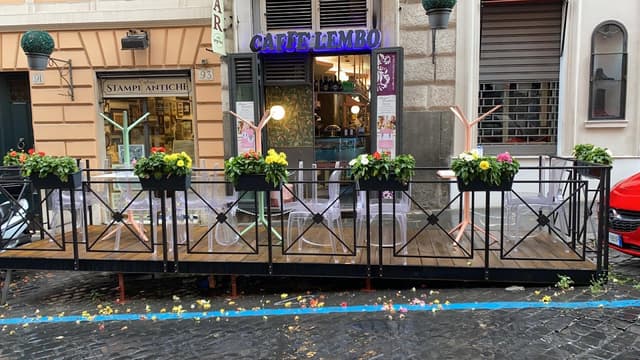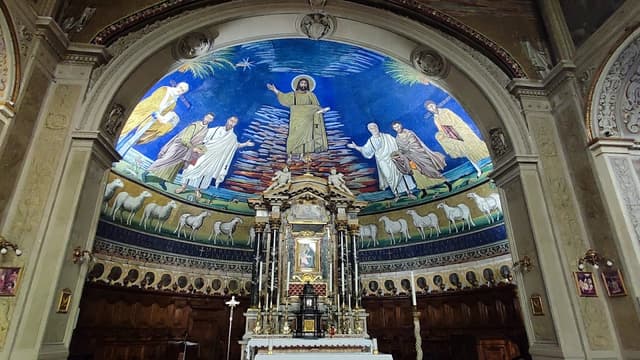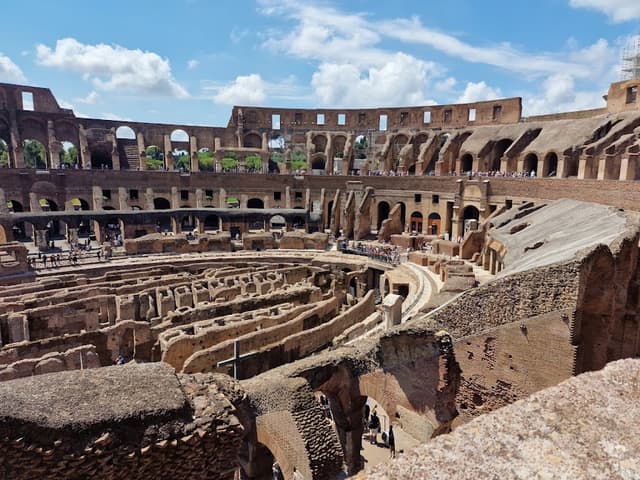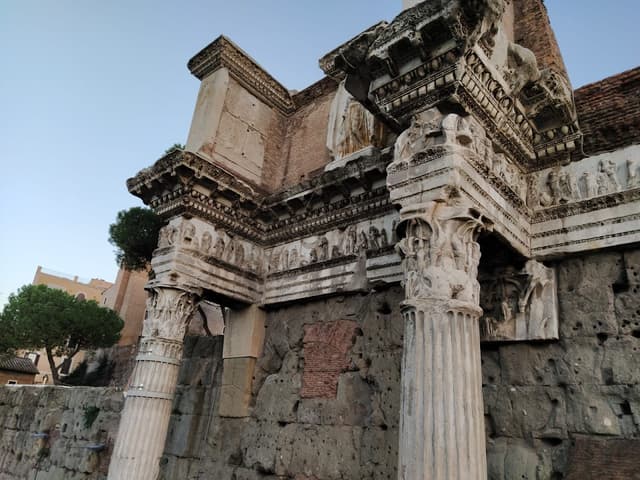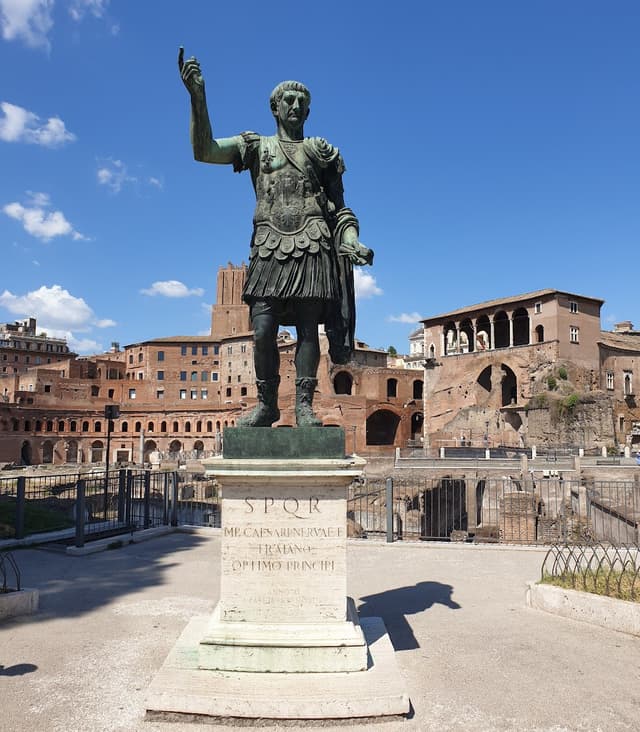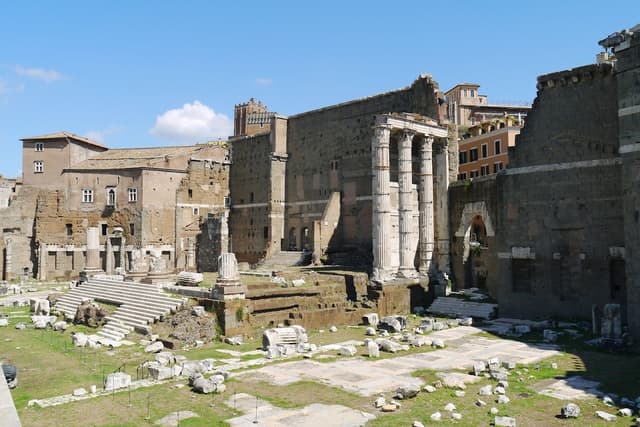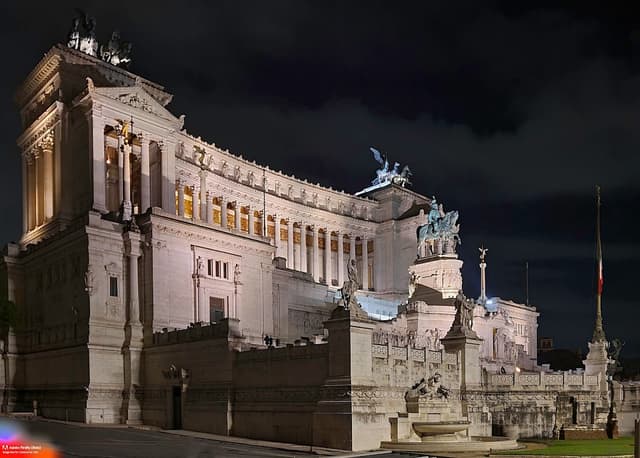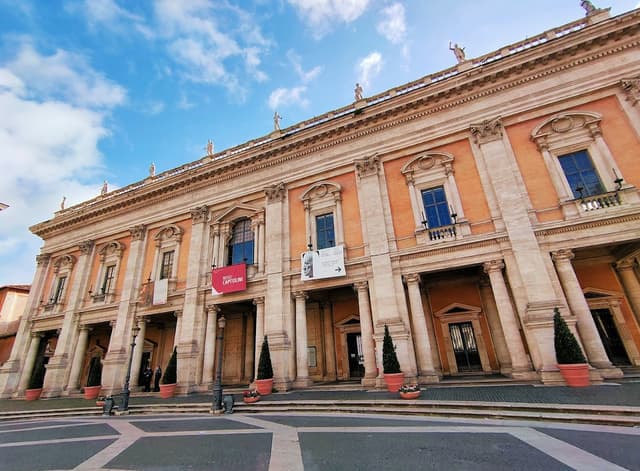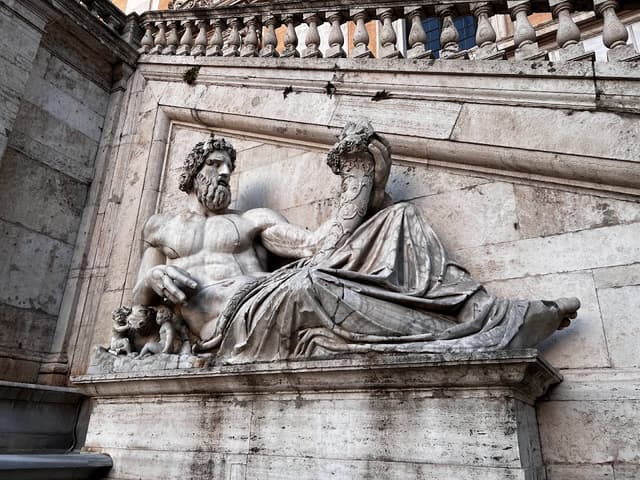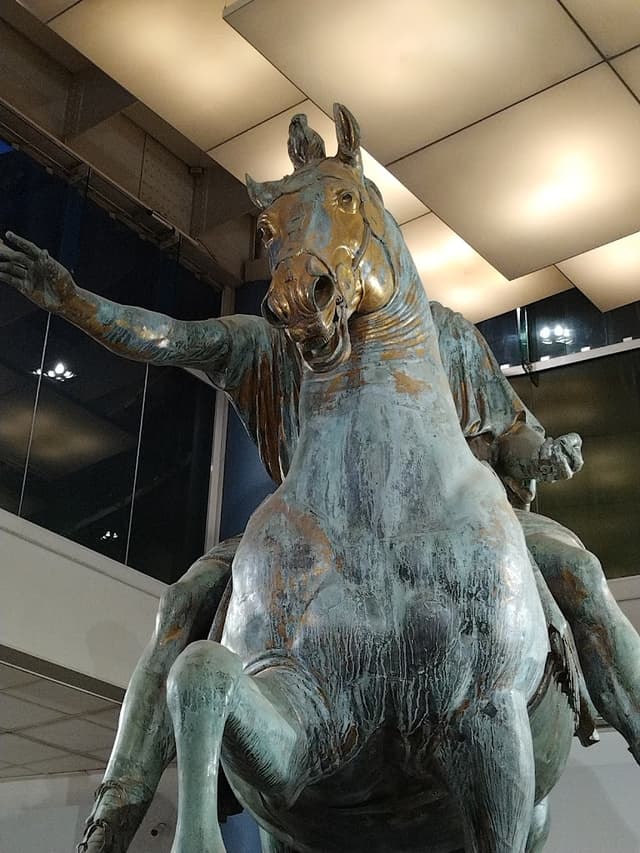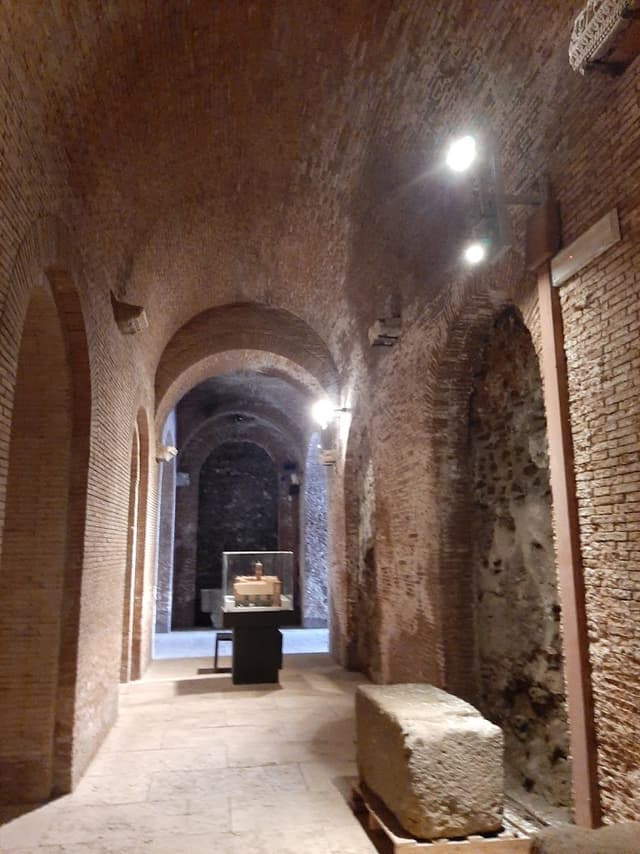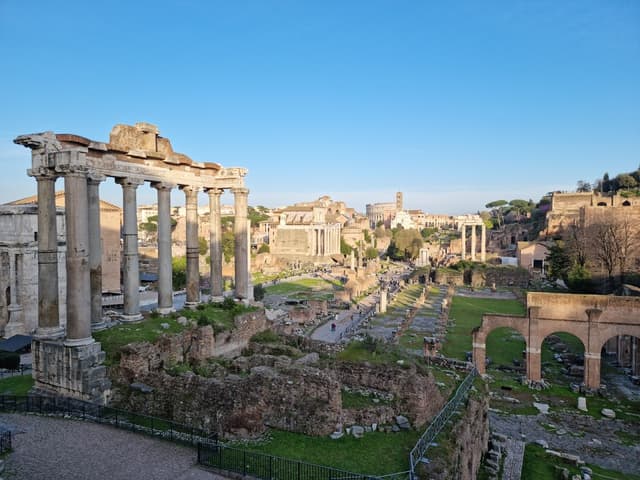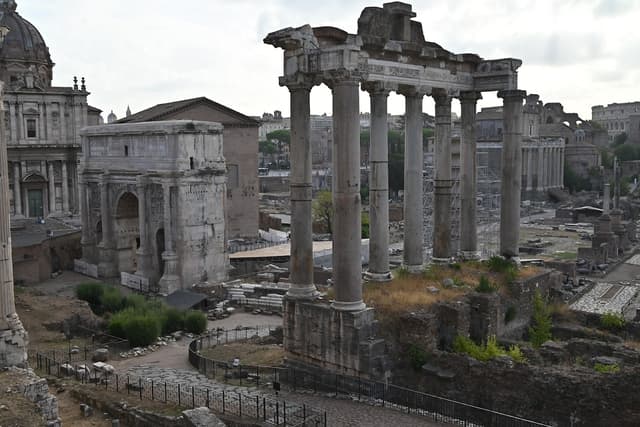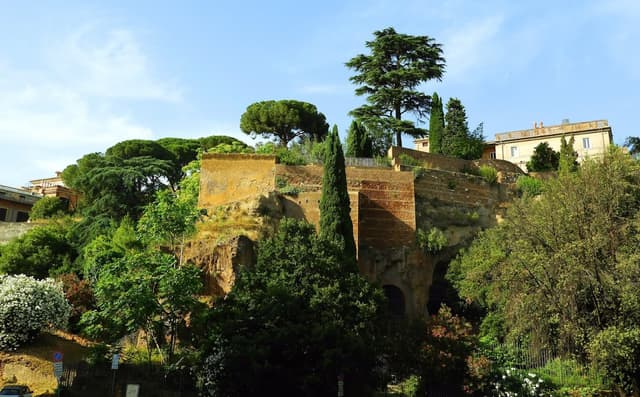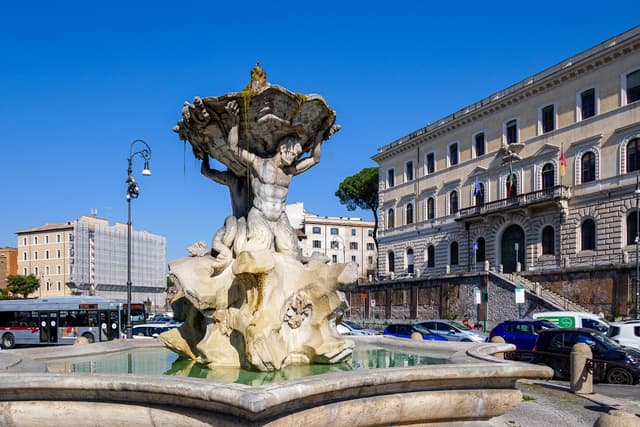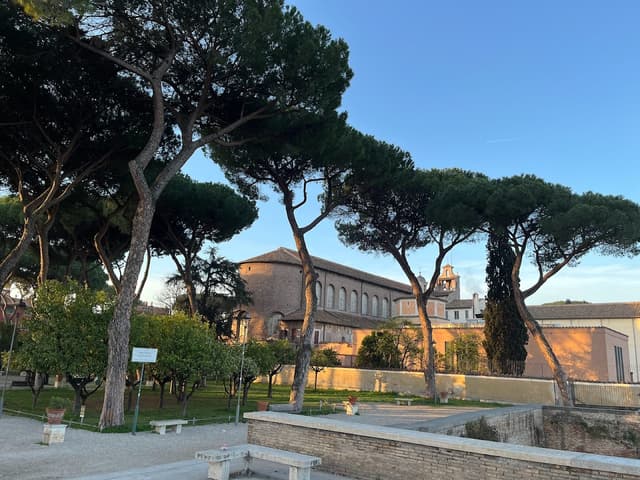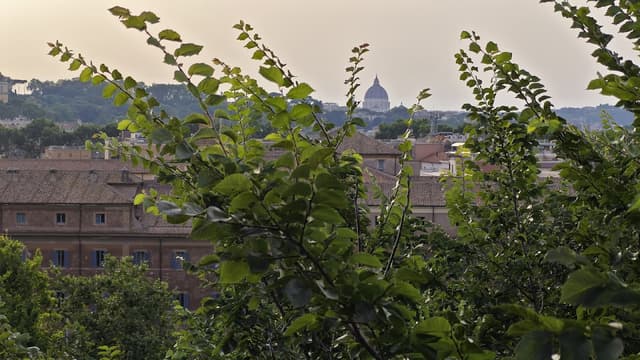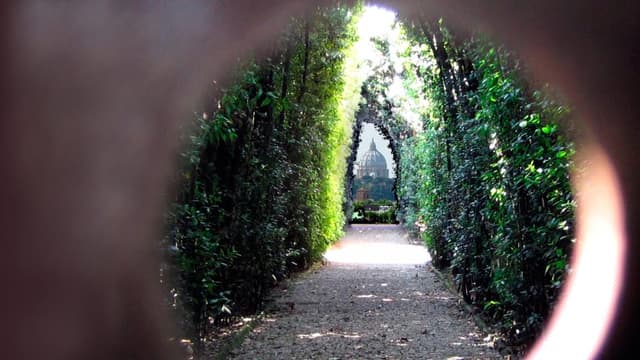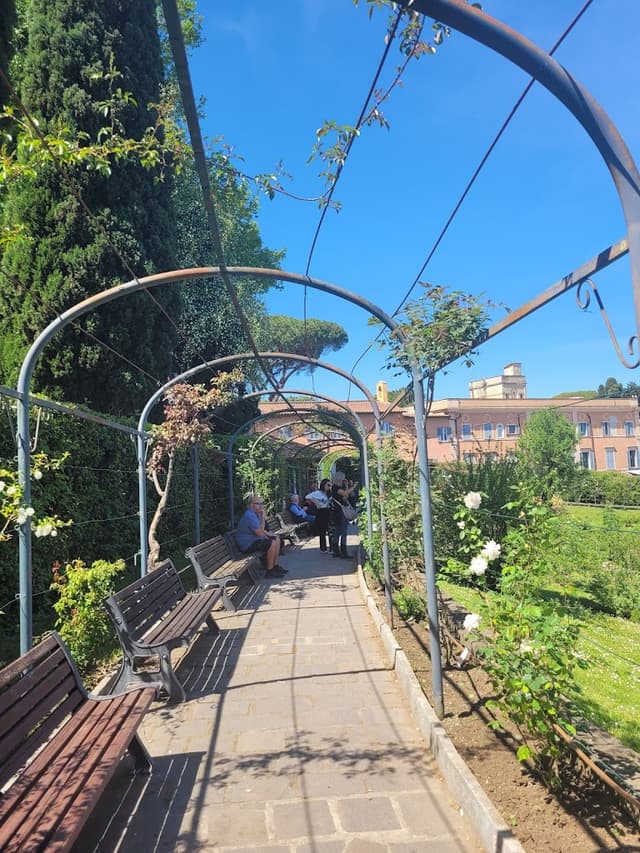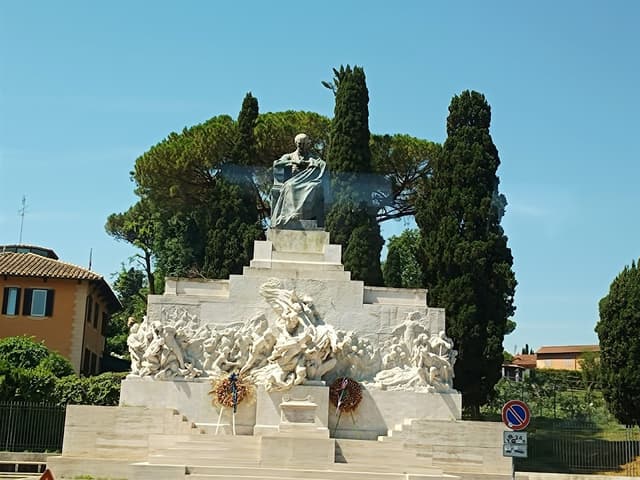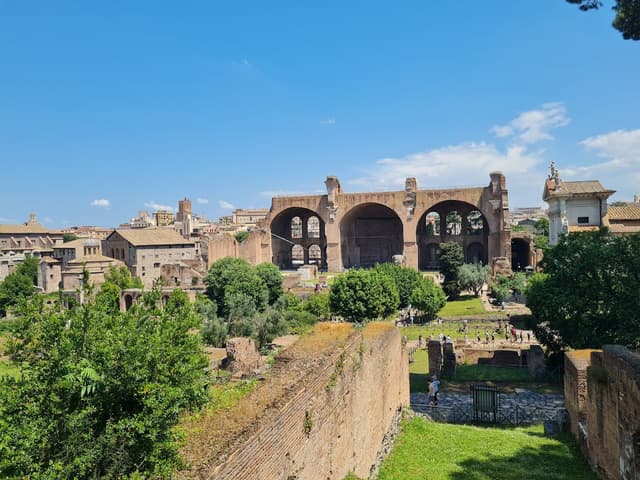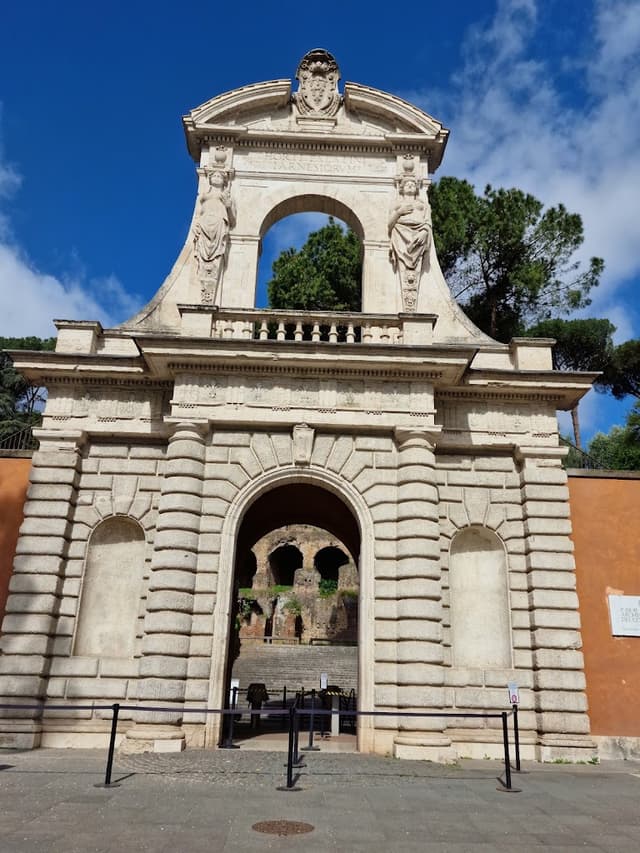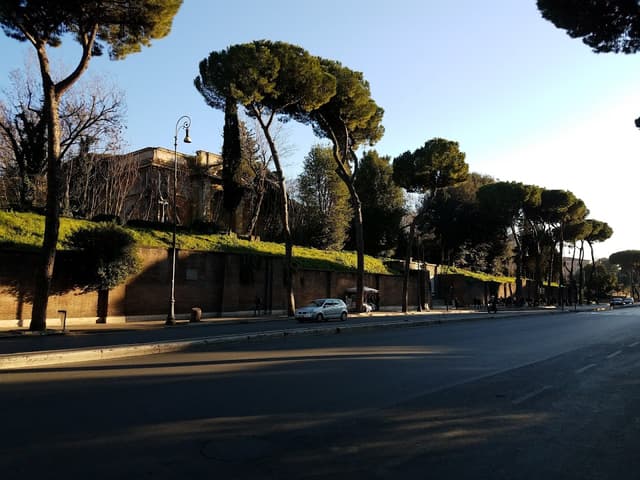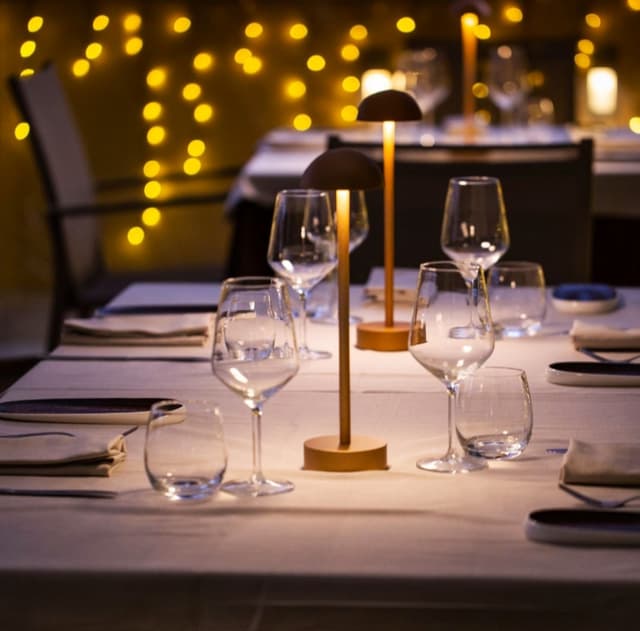Leave hotel at 7:30
Caffè Lembo
@lindamiller
Caffè Lembo is a traditional Italian café located in the Ludovisi neighborhood of Rome. It is known for its delicious coffee, pastries, and sandwiches. The café was founded in 1923 and has been in the Lembo family ever since. It is a cozy and inviting café with a warm atmosphere, and it offers a wide range of coffee drinks, pastries, and sandwiches. Caffè Lembo is a great place to experience a traditional Italian coffee break.

Details
OR
Elsa Coffee
@lindamiller
Elsa Coffee is an American-style coffee shop in Rome known for its high-quality coffee and pastries. It is a great place to relax and enjoy a cup of coffee and a pastry before heading out for a full day touring Rome. Be sure to purchase extra goodies for snacking during the day!

Details
We meet at the Santi Cosma e Damiano. We need to be there by 10:15 AM. So leave coffee place by 8:30.
From hotel to Colosseum 30 minutes. Spend 3 hours at Colosseum. 10:30-2ish
Santi Cosma e Damiano
@lindamiller
The Santi Cosma e Damiano is a basilica church located in the Roman Forum in Rome, Italy. It is dedicated to Saints Cosmas and Damian, two Arabian twin brothers who were martyred in the 4th century AD. The church was built in the 6th century AD and is one of the oldest churches in Rome.
The church is decorated with a variety of mosaics and frescoes. The mosaics in the apse depict the martyrdom of Saints Cosmas and Damian. The frescoes in the nave depict scenes from the Old and New Testaments.

Details

Details
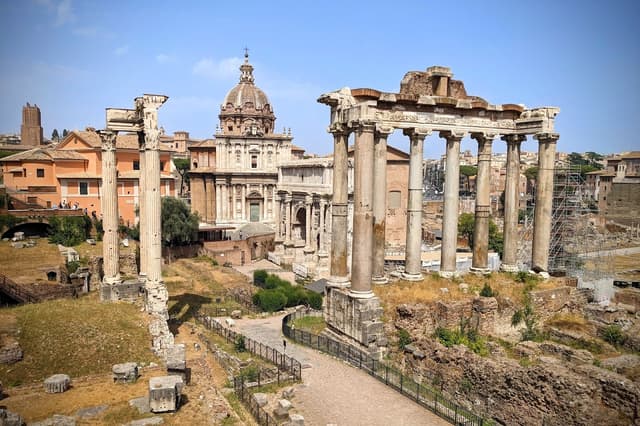
Roman Forum
@lindamiller
The Roman Forum, also known as the Forum Romanum, was the center of ancient Rome. It was a rectangular forum surrounded by the ruins of several important ancient government buildings. The Roman Forum was the site of many important events in Roman history, including public meetings, elections, criminal trials, and gladiatorial contests. It was also a major center for commerce and religion.
The Roman Forum was first used as a public space in the 7th century BC. It was gradually developed over the centuries, and by the time of the Roman Empire, it was one of the most important places in the city. The Roman Forum was lined with temples, basilicas, and other important buildings. It also contained a number of public squares and gardens.
The Roman Forum began to decline in the 4th century AD, as the Roman Empire began to collapse. The buildings were gradually abandoned and fell into ruin. The Roman Forum was rediscovered in the 19th century, and excavations began in the 1800s. Today, the Roman Forum is one of the most popular tourist destinations in Rome.
Here are some of the most important buildings in the Roman Forum:
The Temple of Jupiter: This was the largest and most important temple in the Roman Forum. It was dedicated to Jupiter, the king of the Roman gods.
The Basilica Julia: This was a large basilica that was used for public meetings and trials.
The Senate House: This was the building where the Roman Senate met.
The Curia: This was the building where the Roman Senate met to discuss important matters.
The Rostra: This was a platform where public speakers stood to address the crowd.
The Arch of Titus: This arch was built to commemorate the victory of the Roman emperor Titus over the Jews in 70 AD.

Details
Note: The restaraunt closes at 3:30 We will probably get there around 2:30.
Cross Piazza del Colosseo. Take the stairs.
Turn right onto L.go Gaetana Agnesi
Turn left onto Via degli Annibaldi
Continue onto Via dei Serpenti
Turn left onto Via Baccina
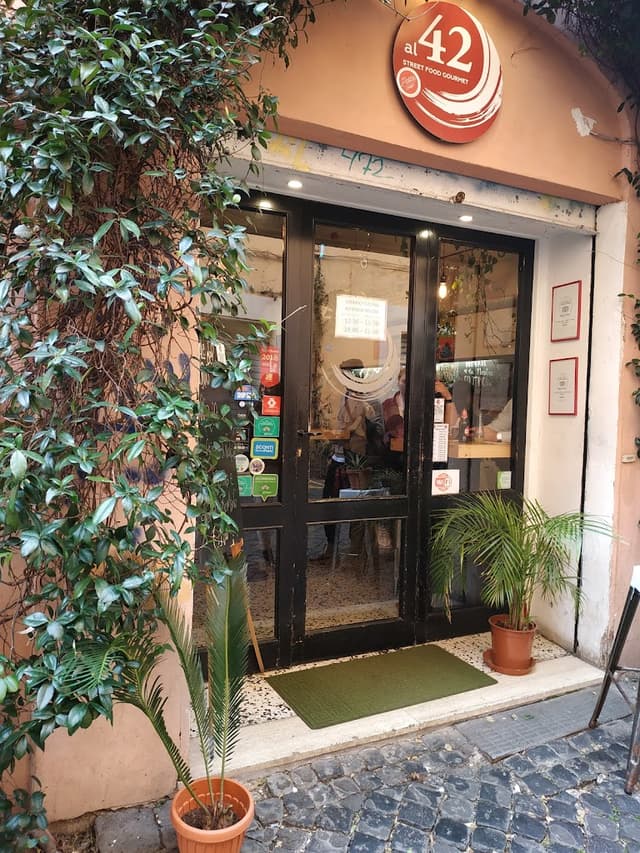
al42 by Pasta Chef rione Monti
@lindamiller
Al42 by Pasta Chef rione is a restaurant located in the Monti district of Rome, Italy. It is owned and operated by Pasta Chef, a company that specializes in handmade pasta. The pasta at Al42 is made fresh daily, and it is used in a variety of dishes, including classic pasta dishes like spaghetti alla carbonara and lasagna, as well as more creative dishes like pasta with truffles and pasta with seafood.
The restaurant also has a selection of meat and fish dishes, as well as a variety of Italian wines.
Al42 is a great place to experience traditional Italian cuisine in a casual and relaxed setting. The restaurant is located in a historic building in the heart of Monti, and it has a warm and inviting atmosphere.
Here are some of the dishes that you can try at Al42:
Spaghetti alla carbonara: This classic Italian dish is made with spaghetti, guanciale, eggs, and Parmesan cheese.
Lasagna: This hearty pasta dish is made with layers of pasta, meat sauce, and béchamel sauce.
Pasta with truffles: This luxurious dish is made with pasta, truffles, and a variety of herbs and spices.
Pasta with seafood: This flavorful dish is made with pasta, seafood, and a light sauce.
Al42 is a great option for a casual dinner in Rome. The restaurant is located in a convenient location, and it offers a variety of delicious Italian dishes.
Here are some reviews of Al42 from TripAdvisor:
"This is a great place to try traditional Italian pasta dishes. The pasta is made fresh daily, and it is cooked perfectly. The service is friendly and attentive. I highly recommend this restaurant."
"I had the pasta with truffles, and it was amazing. The truffles were fresh and flavorful, and the pasta was cooked perfectly. I will definitely be back to try other dishes."
"This is a great place to have a casual dinner in Rome. The food is delicious, and the service is friendly. I would definitely recommend this restaurant to anyone visiting Rome."

Details
Head west on Via Baccina toward Via di Sant'Agata de Goti
Pass by:
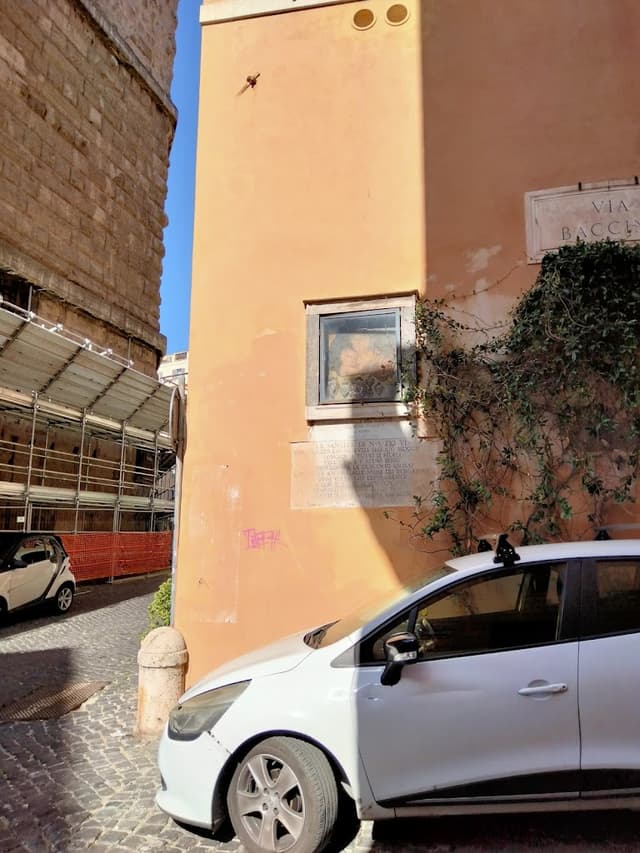
Edicola Sacra - Madonna dell'Arco dei Pantani (Madonna delle Stelle)
@lindamiller
The Edicola Sacra - Madonna dell'Arco dei Pantani (Madonna delle Stelle) is a small shrine located in Via Baccina in the Rione Monti district of Rome, Italy. It is dedicated to the Virgin Mary, and it is a popular pilgrimage site for Catholics.
The shrine is believed to have been built in the 15th century, and it is said to be the site of a miracle that occurred in 1796. On July 9 of that year, the image of the Virgin Mary is said to have moved its eyes, and the event was witnessed by a large crowd. The miracle was recognized by the Catholic Church, and the shrine was officially dedicated to the Virgin Mary.
The shrine is a simple structure, consisting of a small niche that houses a painting of the Virgin Mary. The painting is believed to be from the 15th century, and it depicts the Virgin Mary holding the Christ Child. The shrine is located in a small courtyard, and it is surrounded by a wrought-iron fence.

Details
Cross Via Tor de' Conti and turn left
You will see:

Arco dei Pantani
@lindamiller
The Arco dei Pantani is a triumphal arch located in Rome, Italy. It was built in the 1st century AD by Emperor Tiberius to commemorate the victories of his son Drusus and nephew Germanicus in Germany.
The arch is located in the Forum of Augustus, which was one of the most important public spaces in ancient Rome. It is situated on the southern side of the forum, near the entrance to the Subura, a lower-class neighborhood.
The arch is a single-span arch made of white marble. It is decorated with reliefs depicting the victories of Drusus and Germanicus. The reliefs on the south side of the arch depict Drusus's defeat of the Germanic tribes in the Battle of the Teutoburg Forest in 9 AD. The reliefs on the north side of the arch depict Germanicus's campaigns against the Germanic tribes in the years following the Battle of the Teutoburg Forest.
In the Middle Ages, the area around the Forum of Augustus became marshy and flooded, earning the area the name "Pantani," which means "marshes." The Arco dei Pantani became known as the "Arco dei Pantani" because it was located in this area.
The arch was restored in the 19th century, and it is now a popular tourist destination. It is one of the few remaining triumphal arches in Rome.

Details
On your right:
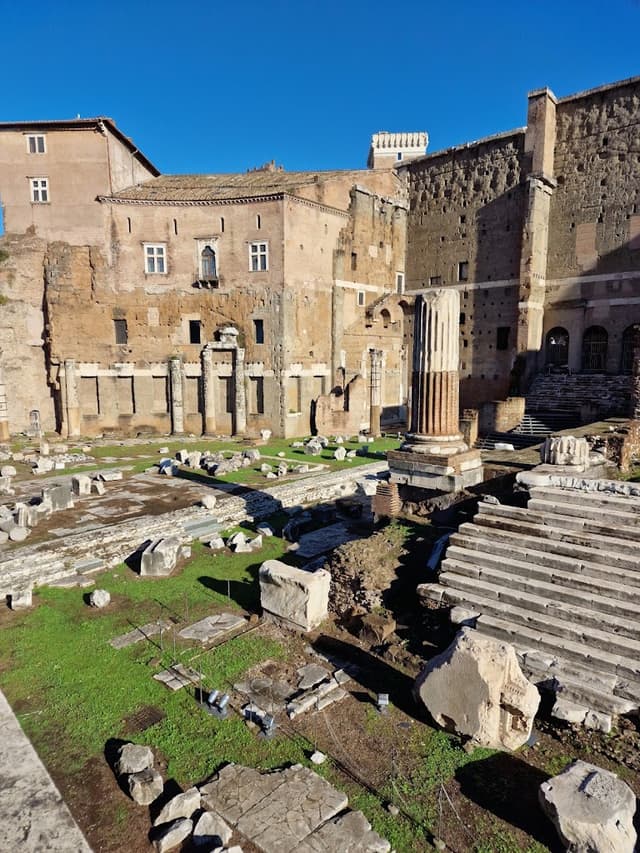
Foro di Augusto
@lindamiller
The Forum of Augustus (Latin: Forum Augustum; Italian: Foro di Augusto) is one of the Imperial fora of Rome, Italy, built by Augustus ( r. 27 BC – AD 14). It includes the Temple of Mars Ultor. The incomplete forum and its temple were inaugurated in 2 BC, 40 years after they were first vowed.
The Forum of Augustus was built to commemorate the victory of Augustus over Brutus and Cassius at the Battle of Philippi in 42 BC. The temple was dedicated to Mars, the Roman god of war, and was intended to be a symbol of Augustus's power and authority.
The Forum of Augustus is located in the north-western part of the city of Rome, between the Capitoline and Palatine Hills. It is a rectangular forum, measuring about 150 meters long and 115 meters wide. The forum is surrounded by a colonnade, and the temple of Mars Ultor is located at the north end of the forum.
The forum was originally decorated with a variety of statues and inscriptions, but most of these have been lost over time. The only remaining statues are the three columns that once supported the temple's portico.
The Forum of Augustus is a significant example of Roman architecture and urban planning. It is a well-preserved example of a Roman forum, and it is a popular tourist destination.
Here are some of the notable features of the Forum of Augustus:
The Temple of Mars Ultor: This temple was dedicated to Mars, the Roman god of war. It was a large temple, with a rectangular plan and a portico supported by six columns on each side.
The semi-circular arcades: These arcades lined the sides of the forum. They were supported by columns, and they provided shade and shelter for visitors.
The Hall of the Colossus: This hall was located at the south end of the forum. It was named after a large statue of Augustus that once stood there.

Details
Head south on Via Tor de' Conti toward Via Baccina
Slight right toward Largo Corrado Ricci Take the stairs
On your right:
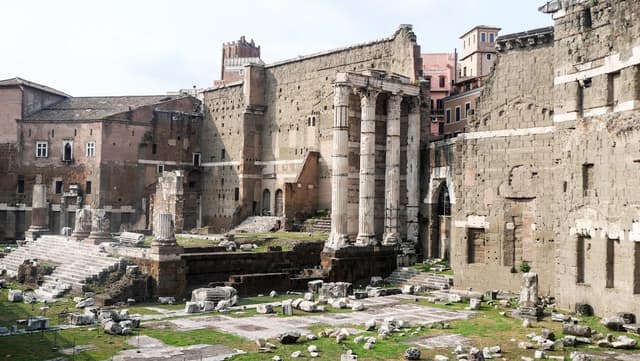
Forum of Nerva
@lindamiller
The Forum of Nerva (Italian: Foro di Nerva; Latin: Forum Nervae) is an ancient structure in Rome, Italy, chronologically the next to the last of the Imperial fora built.
The Forum of Nerva was the fourth and smallest of the imperial fora. Its construction was started by Emperor Domitian before the year 85 AD, but was officially completed and opened by his successor, Nerva, in 97 AD, hence its official name.
The street, which the forum replaced, the Argiletum, had long served as a market area, especially for booksellers and cobblers; the new forum continued to serve as both a thoroughfare and as a monumental entrance to the larger Roman Fora.
The Forum of Nerva was a relatively small and simple forum, but it was also one of the most elegant. It was built in a transitional style, rectangular in shape, and surrounded by a colonnade made of white marble.
The central feature of the forum was a temple dedicated to Minerva. It was a small temple, but it was also very elegant. The temple was made of white marble, and it was supported by columns with Ionic capitals.
Today, the ruins of the Forum of Nerva can still be seen in Rome. They are located just north of the Roman Forum, and they are accessible to the public.

Details
After the stairs, turn right. Keep going.
Le "Colonnacce"
@lindamiller
Le "Colonnacce" (The Big Columns) is a pair of Corinthian columns that are the only remaining portion of the Forum of Nerva in Rome. The columns were built in the early 2nd century CE and are located next to the Temple of Minerva.
The columns are approximately 16 meters tall and are made of white marble. They are decorated with capitals that feature acanthus leaves and volutes (spiral scrolls). The columns are also decorated with a frieze that depicts the story of Minerva.
The columns were originally part of a series of columns that lined the perimeter of the Forum of Nerva. The other columns have been destroyed, but the two columns that remain are a reminder of the grandeur of the forum.
The columns were nicknamed "Le Colonnacce" (The Big Columns) by the Romans because they are much larger than the other columns in the city.

Details
Turn right onto Via dei Fori Imperiali. Keep going.
Look to your left across the street to see the Statue of Julius Caesar and the Forum of Caesar.
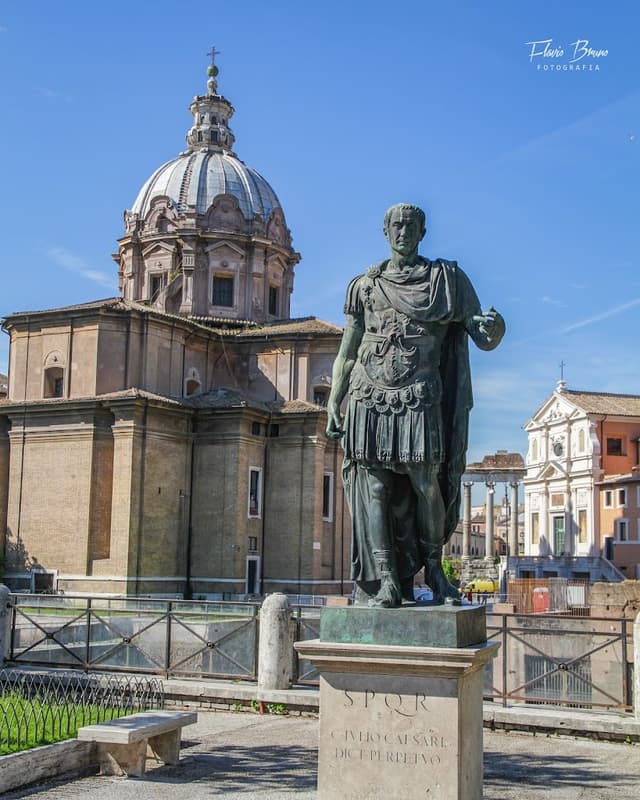
Statue of Julius Caesar
@lindamiller
The Statue of Julius Caesar on Via dei Fori Imperiali in Rome is a bronze statue of the Roman general and statesman Julius Caesar (100-44 BC). It is a copy of an ancient marble statue of Caesar, which now stands in Palazzo Senatorio, the seat of Rome's city council.
The statue was commissioned by the Italian fascist dictator Benito Mussolini and was unveiled in 1936. It is located at the entrance to the Via dei Fori Imperiali, a road that was built by Mussolini to connect the city's major Imperial Fora (forums).
The statue depicts Caesar standing in a regal pose, with his left hand raised in a gesture of command. He is dressed in a toga and wears a laurel wreath on his head. The statue is a symbol of Caesar's power and authority and of Mussolini's own aspirations for imperial greatness.
The statue has been controversial since its erection. Critics have accused it of being a symbol of fascism and of glorifying Caesar's tyranny. However, others argue that the statue is a valuable historical artifact and a reminder of Rome's rich past.

Details
Behind him:
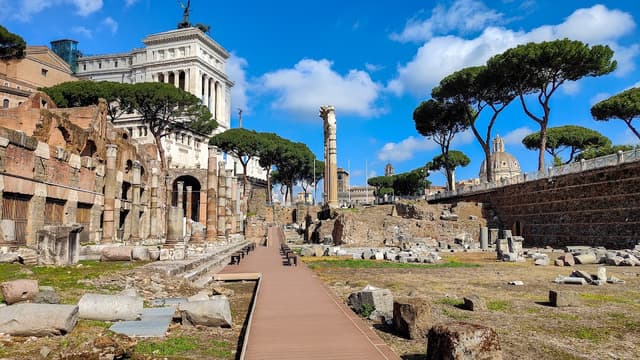
Forum Iulium
@lindamiller
The Forum of Caesar (Latin: Forum Iulium) was the first of the imperial fora to be built in Rome. It was constructed by Julius Caesar in 54 BC, and was designed to serve as a new administrative and judicial center for the city. The forum was located just north of the Roman Forum and was connected to it by a series of ramps and stairways.
The Forum of Caesar was a rectangular complex, surrounded by a portico on three sides. The fourth side was occupied by a temple dedicated to Venus Genetrix, the mother of Aeneas. The forum also included a number of other important buildings, such as the Curia Julia (the new Senate house), the Basilica Julia (a large courtroom), and the Tabularium (the archive building).
The Forum of Caesar was a major achievement in Roman architecture and urban planning. It was the first of the imperial fora to be built in a monumental style, and it set the standard for future forum construction. The forum was also a significant symbol of Caesar's power and prestige, and it played an important role in his political career.
The Forum of Caesar was used for a variety of purposes, including public meetings, trials, and religious ceremonies. It was also a popular place for people to gather and socialize. The forum remained in use until the 6th century AD when it was gradually abandoned and fell into ruin.
Today, the ruins of the Forum of Caesar can still be seen in Rome. They are located just north of the Roman Forum and are accessible to the public.

Details
On the right:
Statua di Traiano
@lindamiller
The Statue of Trajan
This is supposed to be on the via dei Fori Imperiali; however, we need to check to see if it really is.
The Statue of Trajan was an important work of imperial propaganda. It depicted Trajan as a skilled military leader and a just ruler. The statue was also a symbol of the power and prosperity of the Roman Empire.
The Statue of Trajan was destroyed in the Middle Ages. However, many copies have survived, including a bronze replica that is located in the National Archaeological Museum of Naples.

Details
Behind him:
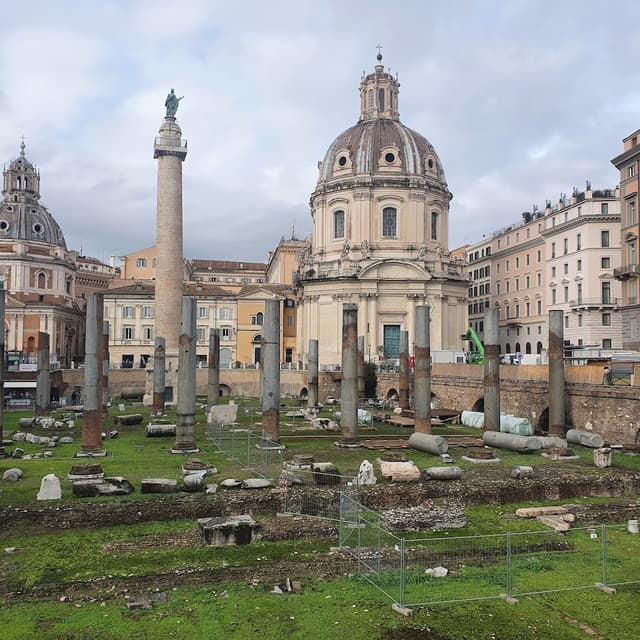
Trajan Forum
@lindamiller
The Forum of Trajan is the last of the Imperial fora to be constructed in ancient Rome. It was built by the Emperor Trajan with the spoils of war from the conquest of Dacia, which ended in 106. The construction began between 105 and 107; according to the Fasti Ostienses the Forum was inaugurated in 112. Trajan's Column was erected and then inaugurated in 113.
The Forum of Trajan is a vast complex, measuring 300 meters (984 feet) long and 185 meters (607 feet) wide. It is located on the Quirinal Hill, just north of the Roman Forum. The forum is surrounded by a colonnaded portico, and it is divided into two main parts: the Forum proper and the Markets of Trajan.
The Forum proper is a rectangular space, surrounded by a portico on three sides. The fourth side is occupied by the Basilica Ulpia, a large law court and administrative building. The forum also includes a temple dedicated to Trajan, a library, and a number of other public buildings.
The Markets of Trajan are a complex of shops, warehouses, and offices. They are located on a series of terraces that descend from the Forum proper to the Via Biberatica. The markets are a masterpiece of Roman engineering, and they are still in use today.
The Forum of Trajan was a major achievement in Roman architecture and urban planning. It was the largest and most impressive of the Imperial fora, and it was a symbol of Trajan's power and prestige. The forum was also a popular place for people to gather and socialize.
The Forum of Trajan is a UNESCO World Heritage Site and is one of the most popular tourist destinations in Rome. It is a reminder of the grandeur and power of ancient Rome.
Here are some of the most notable features of the Forum of Trajan:
Trajan's Column: A 38-meter (125-foot) tall column that commemorates Trajan's victories in Dacia. The column is decorated with a spiral frieze that depicts the Dacian Wars.
Basilica Ulpia: A large law court and administrative building that was one of the largest buildings in the Roman Empire.
Markets of Trajan: A complex of shops, warehouses, and offices that was a major commercial center in ancient Rome.
Temple of Trajan: A temple dedicated to Trajan that was located on the eastern side of the Forum.
Library of Trajan: A library that housed a collection of books and scrolls.

Details
Toward the end of the street, across from the Fontana dell'Adriatico, on the right:
Imperial Fora
@lindamiller
The Imperial Fora are a series of monumental fora, constructed in Rome over a period of one and a half centuries, between 46 BC and 113 AD. The fora were the center of the Roman Republic and of the Roman Empire.
The Imperial Fora were built by successive emperors, each one trying to outdo his predecessor in terms of size and grandeur. The fora were used for a variety of purposes, including public meetings, trials, religious ceremonies, and commerce. They were also popular places for people to gather and socialize.
The five Imperial Fora are:
Forum Iulium (Forum of Julius Caesar): The first of the Imperial Fora, built in 54 BC by Julius Caesar.
Forum Augusti (Forum of Augustus): Built in 2 BC by Augustus.
Forum Pacis (Forum of Vespasian): Built in 75 AD by Vespasian.
Forum Transitorium (Forum of Nerva): Built in 98 AD by Nerva.
Forum Traiani (Forum of Trajan): The largest and most impressive of the Imperial Fora, built in 113 AD by Trajan.

Details
Cross the street.
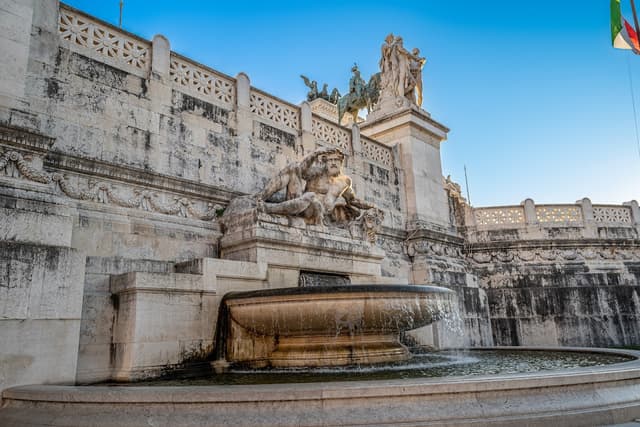
Fontana dell'Adriatico
@lindamiller
The Fontana dell'Adriatico (Fountain of the Adriatic) is a fountain located in Piazza Venezia in Rome. It was designed by Pietro Canonica and was completed in 1911. The fountain is one of two fountains that flank the Vittorio Emanuele II Monument, the other being the Fontana del Tirreno (Fountain of the Tyrrhenian Sea).
The Fontana dell'Adriatico is a large, ornate fountain. It is made of white marble and is topped by a statue of a reclining male figure. The figure is the personification of the Adriatic Sea, and he is depicted as a muscular, bearded man with long hair. He is lying on his back, with his head supported by his right hand. His left hand is resting on a lion, which is the symbol of Venice.
The fountain is surrounded by a pool of water. The water flows from the statue's mouth and falls into the pool. The pool is lined with marble steps, which lead down to the water's edge.
Here are some additional details about the fountain:
The statue of the Adriatic Sea is 7.5 meters (25 feet) tall.
The fountain is 25 meters (82 feet) wide and 10 meters (33 feet) deep.
The fountain is made of Carrara marble.
The fountain was designed by Pietro Canonica, a famous Italian sculptor.
The fountain was completed in 1911.
The Fontana dell'Adriatico is a symbol of the Adriatic Sea, which is a major body of water that borders Italy, Slovenia, Croatia, Bosnia and Herzegovina, Montenegro, Albania, and Greece. The fountain is a reminder of the importance of the Adriatic Sea to Italy's history and culture.

Details
Follow the path around the fountain (away from the street). To your left you will see the Altar of the Fatherland.
Altar of the Fatherland
@lindamiller
The Altar of the Fatherland (Italian: Altare della Patria) is a large national monument built between 1885 and 1935 to honour Victor Emmanuel II, the first king of a unified Italy, in Rome, Italy. It occupies a site between the Piazza Venezia and the Capitoline Hill.
The monument was designed by Giuseppe Sacconi and is built in a neoclassical style. It is made of white marble and is decorated with a variety of sculptures and reliefs. The central part of the monument is a large staircase that leads up to a platform on which stands a statue of Victor Emmanuel II on horseback.
The Altar of the Fatherland is also known as the Vittoriano, after Victor Emmanuel II. It is sometimes referred to as the "Wedding Cake" or the "Typewriter" due to its appearance.

Details
A little ways away you will see the Monument to Victor Emmanual.
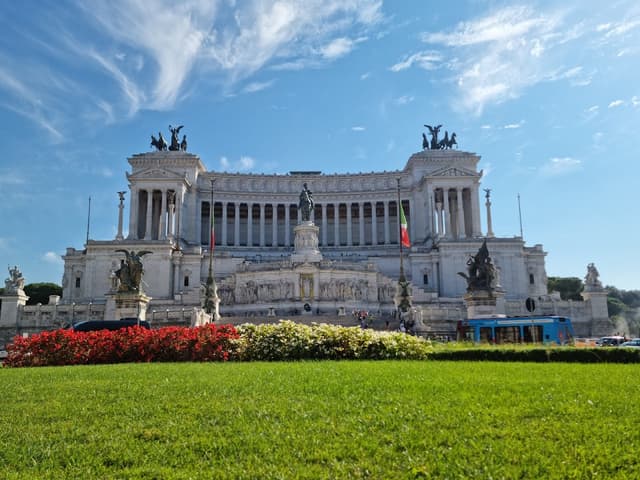
Monument to Victor Emmanuel II
@lindamiller
The Monument to Victor Emmanuel II (Italian: Monumento Nazionale a Vittorio Emanuele II), also known as the Vittoriano or Altare della Patria (Altar of the Fatherland), is a large national monument built between 1885 and 1935 to honour Victor Emmanuel II, the first king of a unified Italy, in Rome, Italy. It occupies a site between the Piazza Venezia and the Capitoline Hill. The monument was realized by Giuseppe Sacconi.
The monument is a massive white marble structure that is over 130 meters high. It is decorated with a variety of statues, columns, and reliefs. The most notable feature of the monument is the equestrian statue of Victor Emmanuel II, which is located at the top of the monument.
The Monument to Victor Emmanuel II is a popular tourist destination, and it offers stunning views of the city. It is also a significant historical site, as it is a reminder of the unification of Italy in the 19th century.
Here are some additional details about the Monument to Victor Emmanuel II:
The monument is made of white marble from Carrara, Italy.
The monument is 135 meters high, 130 meters wide, and 70 meters deep.
The monument is decorated with over 200 statues and reliefs.
The monument is home to the Tomb of the Unknown Soldier, which is located at the base of the equestrian statue of Victor Emmanuel II.
The monument is open to the public, and visitors can climb to the top of the monument for stunning views of the city.
The Monument to Victor Emmanuel II is a controversial monument, and it has been criticized for its size, its style, and its cost. However, it is also a significant historical site and a popular tourist destination.

Details
Follow around the front (back toward the street) to see the statue of "The Thought."

Statua “Il Pensiero” di Giulio Monteverde
@lindamiller
Note: this is not the right description.
The statue "Il Pensiero" (The Thought) by Giulio Monteverde is a monumental sculpture located on the Vittoriano in Rome. It is one of the most iconic sculptures in Italy, and it is a symbol of thought, contemplation, and inspiration.
The statue was commissioned in 1907 by the Italian government to commemorate the unification of Italy. It was completed in 1911 and was originally placed on the top of the Vittoriano. In 1925, it was moved to its current location on the side of the monument.
Monteverde was inspired to create the statue after reading the poem “Il Pensiero” by Giacomo Leopardi. The poem is a meditation on the nature of thought and the human condition. Monteverde wanted to create a sculpture that would capture the essence of Leopardi's poem, and he succeeded in creating a work that is both thought-provoking and visually stunning.
The statue has been interpreted in a variety of ways. Some see it as a representation of the Italian people's thoughts and aspirations for the future. Others see it as a more universal symbol of thought and contemplation.
No matter how it is interpreted, "Il Pensiero" is a powerful and moving sculpture that has captured the imagination of people around the world.

Details
Walk past:
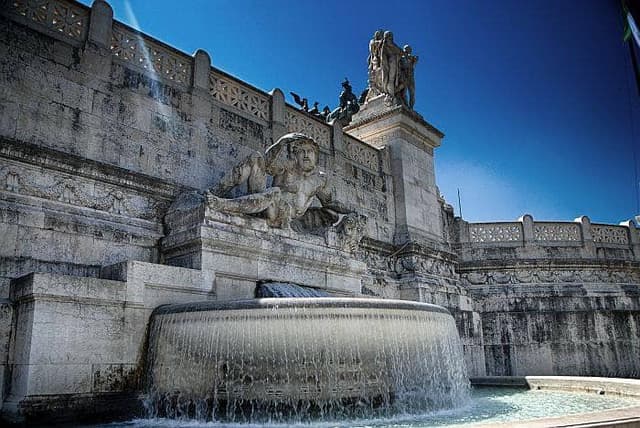
Fountain of the Tyrrhenian
@lindamiller
The Fountain of the Tyrrhenian Sea (Italian: Fontana del Tirreno) is a fountain located in Piazza Venezia in Rome. Like its sister fountain, the Fontana dell'Adriatico (Fountain of the Adriatic Sea), tt was designed by Pietro Canonica and was completed in 1911.
The Fountain of the Tyrrhenian Sea is also made of white marble and is topped by a statue of a reclining male figure, who is supposed to be the personification of the Tyrrhenian Sea. The figure is lying on his back, with his left hand is resting on a wolf, which is the symbol of Rome.
Here are some additional details about the fountain:
The statue of the Tyrrhenian Sea is 7.5 meters (25 feet) tall.
The fountain is 25 meters (82 feet) wide and 10 meters (33 feet) deep.
The fountain is made of Carrara marble.
The fountain was designed by Pietro Canonica, a famous Italian sculptor.
The fountain was completed in 1911.
The Fountain of the Tyrrhenian Sea is a symbol of the Tyrrhenian Sea, which is a major body of water that borders Italy, France, Corsica, and Sardinia. The fountain is a reminder of the importance of the Tyrrhenian Sea to Italy's history and culture.
The Tyrrhenian Sea is named after the Tyrrhenian people, who were an ancient people of Italy. The Tyrrhenian Sea is a popular tourist destination, and it is known for its beautiful beaches, clear waters, and mild climate.

Details
Up the street and on your left:
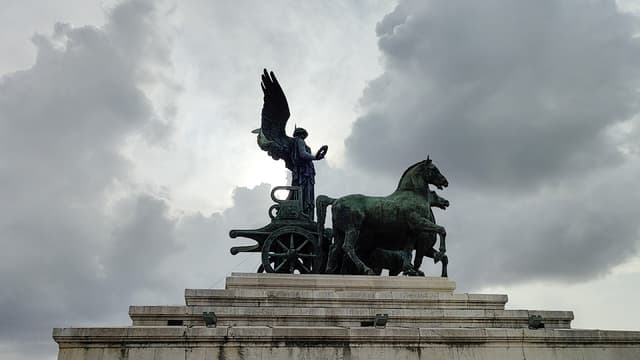
Quadriga della Libertà
@lindamiller
The Quadriga della Libertà (Quadriga of Liberty) is a bronze sculpture located on the top of the Vittoriano in Rome, Italy. It was designed by Paolo Bartolini and was completed in 1927.
The Quadriga is a chariot drawn by four horses. The horses are rearing up on their hind legs, and they are being driven by a winged woman. The woman is wearing a flowing gown and a crown of stars. She is holding aloft a torch, which is a symbol of liberty.
The Quadriga is a symbol of Italian unity and freedom. It was commissioned by the Italian government to commemorate the unification of Italy in 1861. The sculpture is a reminder of the country's commitment to liberty and democracy.
Here are some additional details about the Quadriga:
The Quadriga is made of bronze and is approximately 11 meters (36 feet) tall.
The sculpture is located on the top of the Vittoriano, a large national monument dedicated to Victor Emmanuel II, the first king of a unified Italy.
The Quadriga was designed by Paolo Bartolini, a famous Italian sculptor.
The Quadriga was completed in 1927.
The Quadriga is a popular tourist destination and is often photographed and painted. It is a reminder of Italy's rich history and culture.
The Quadriga has been interpreted in many different ways. Some see it as a representation of the Roman goddess of liberty, Libertas. Others see it as a symbol of the Italian people's struggle for freedom.
The Quadriga is a powerful and moving work of art. It is a reminder of the importance of liberty and democracy in our lives.

Details
Also on your left:
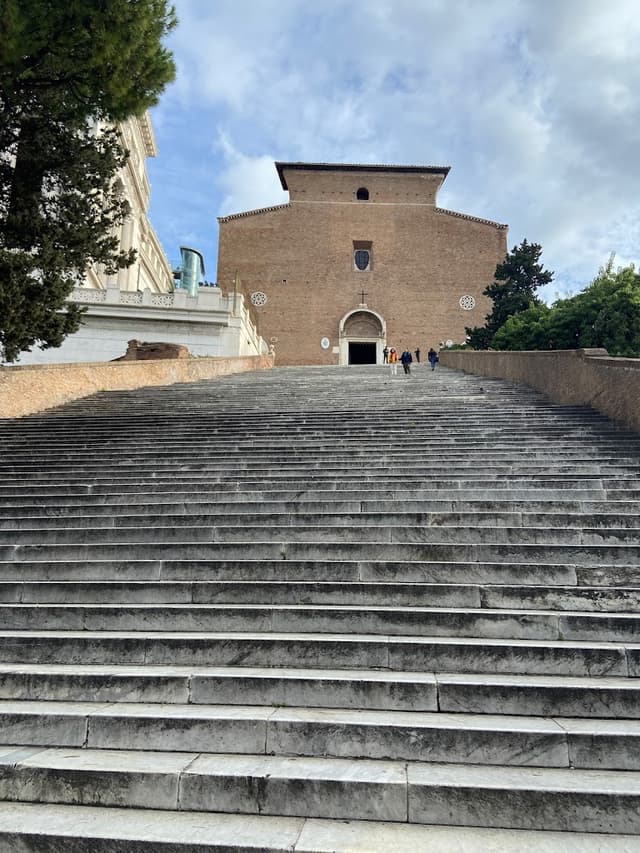
Ara Coeli Staircase
@lindamiller
The Ara Coeli Staircase is a monumental staircase in Rome, Italy, that leads up to the Basilica of Santa Maria in Aracoeli. It is located on the Capitoline Hill, just north of the Roman Forum.
The staircase was built in the 14th century to celebrate the end of the Black Death in Rome. It is made of 124 white marble steps and is decorated with a series of statues and reliefs. The statues depict a variety of religious figures, including the Virgin Mary, Jesus Christ, and the saints. The reliefs depict scenes from the Bible and from Roman history.
The Ara Coeli Staircase is a popular tourist destination and is often photographed and painted. It is also a place of pilgrimage for Christians. Many pilgrims climb the stairs on their knees as an act of devotion to the Virgin Mary.
Here are some additional details about the Ara Coeli Staircase:
The staircase is made of 124 white marble steps.
It is decorated with a series of statues and reliefs.
The statues depict a variety of religious figures, including the Virgin Mary, Jesus Christ, and the saints.
The reliefs depict scenes from the Bible and from Roman history.
The Ara Coeli Staircase is a popular tourist destination and is often photographed and painted.
It is also a place of pilgrimage for Christians. Many pilgrims climb the stairs on their knees as an act of devotion to the Virgin Mary.
The Ara Coeli Staircase is a significant monument in Roman history and culture. It is a reminder of the city's long and rich history, and it is a place of pilgrimage for people from all over the world.

Details
At the intersection. Turn left on Via del Teatro di Marcello.
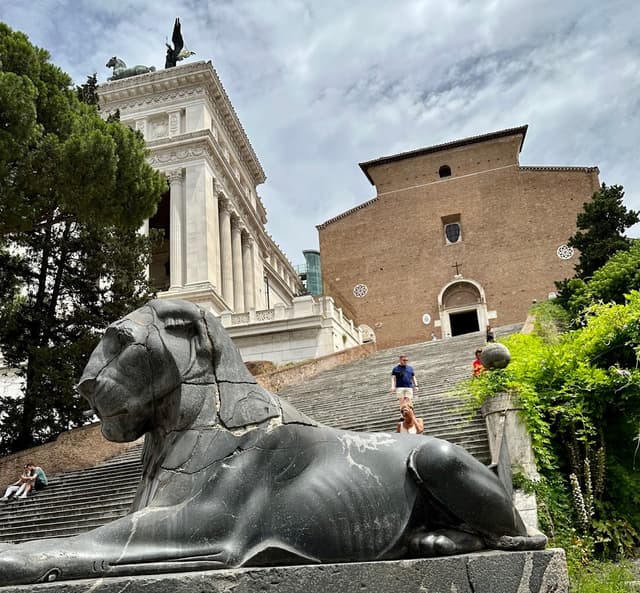
Fontane dei Leoni Egizi
@lindamiller
The Fontane dei Leoni Egizi (Fountains of the Egyptian Lions) are two fountains located in Piazza del Campidoglio in Rome, Italy. They were designed by Michelangelo in the 16th century and are considered one of his most important works.
The fountains are made of travertine marble and are each decorated with a pair of Egyptian lions. The lions are standing on pedestals and are holding a basin in their paws. The basins are filled with water, which flows down into the fountain pool.
The Fontane dei Leoni Egizi were built to provide a grand entrance to the Capitoline Hill, which was the seat of government in ancient Rome. They are also a popular tourist destination and are often photographed and painted.
Here are some additional details about the Fontane dei Leoni Egizi:
The fountains are made of travertine marble.
They are each decorated with a pair of Egyptian lions.
The lions are standing on pedestals and are holding a basin in their paws.
The basins are filled with water, which flows down into the fountain pool.
The fountains were built to provide a grand entrance to the Capitoline Hill.
They are also a popular tourist destination.
The Fontane dei Leoni Egizi are a significant work of art and architecture. They are a reminder of Michelangelo's genius and the importance of the Capitoline Hill in Roman history.

Details
You'll be going up some stairs:
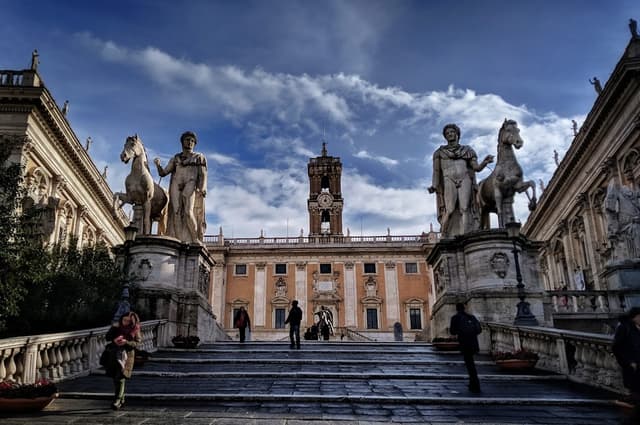
Cordonata Capitolina
@lindamiller
The Cordonata Capitolina is a monumental staircase in Rome, Italy, that connects the Piazza d'Aracoeli with the Piazza del Campidoglio. It was designed by Michelangelo in the 16th century and is considered one of his most important works.
The Cordonata is a wide, shallow staircase that is made of travertine marble. It is divided into three sections, each of which is decorated with statues and reliefs. The first section is decorated with statues of the Dioscuri, Castor and Pollux, and the second section is decorated with the Trophies of Marius, a Roman victory monument. The third section is decorated with a statue of Cola di Rienzo, a 14th-century Roman revolutionary.
The Cordonata was built to provide a grand entrance to the Capitoline Hill, which was the seat of government in ancient Rome. It is also a popular tourist destination and is often photographed and painted.
Here are some additional details about the Cordonata Capitolina:
The Cordonata is made of travertine marble.
It is divided into three sections.
The first section is decorated with statues of the Dioscuri.
The second section is decorated with the Trophies of Marius.
The third section is decorated with a statue of Cola di Rienzo.
The Cordonata is a significant work of art and architecture. It is a reminder of Michelangelo's genius and the importance of the Capitoline Hill in Roman history.

Details
On your left:
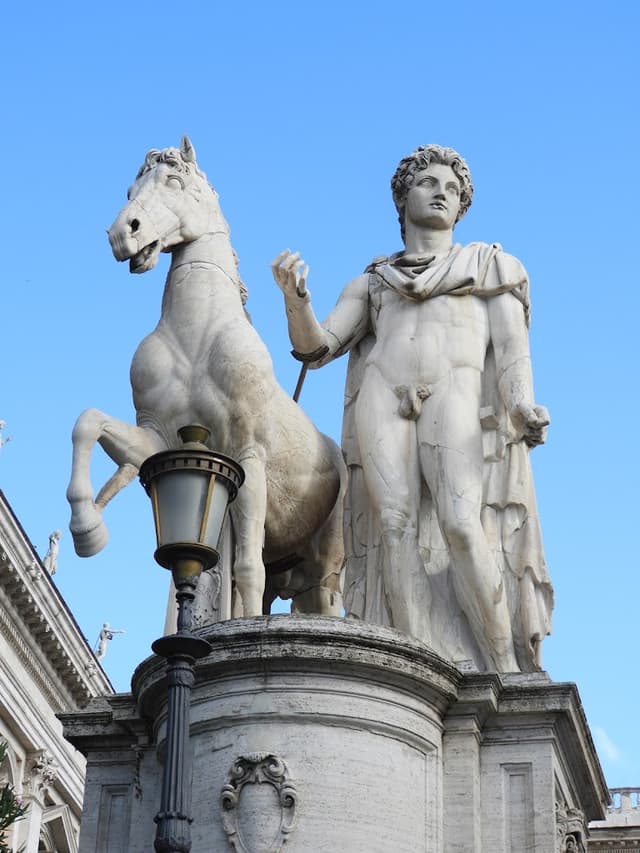
Statua di Castore
@lindamiller
The Statua di Castore is a marble statue of the god Castor, one of the Dioscuri, located on the Capitoline Hill in Rome, Italy. It is one of a pair of statues, the other being a statue of Pollux, his twin brother. The statues are located at the top of the Cordonata, a grand staircase that leads up to the Piazza del Campidoglio.
The statue of Castor is believed to be a Roman copy of a Greek original from the 2nd century AD. It is made of white marble and is about 5.8 meters tall. The statue depicts Castor standing in a contrapposto pose, with his weight on his right leg. He is wearing a helmet, a short chiton, and a cloak. He is holding a spear in his right hand and a bridle in his left hand.
The statue of Castor is a significant work of art and a reminder of the importance of the Dioscuri in Roman mythology. The Dioscuri were twin brothers who were worshipped as gods of horses, athletes, and warriors. They were often depicted as protectors of Rome, and they were believed to have appeared on the battlefield at times of need.

Details
On your right a little in the distance:
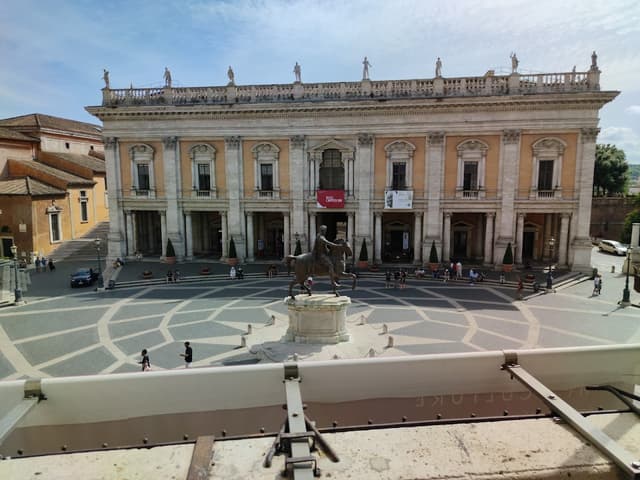
Capitoline Museums
@lindamiller
The Capitoline Museums (Italian: Musei Capitolini) are a group of art and archaeological museums in Piazza del Campidoglio, on top of the Capitoline Hill in Rome, Italy. The historic seats of the museums are Palazzo dei Conservatori and Palazzo Nuovo, facing on the central trapezoidal piazza in a plan conceived by Michelangelo in 1536 and executed over a period of more than 400 years. The museums comprise eleven distinct collections, including several temporary exhibitions.
The history of the museum can be traced to 1471, when Pope Sixtus IV donated a collection of important ancient bronzes to the people of Rome and located them on the Capitoline Hill. The collection grew steadily over the centuries, and in the 18th century, two new buildings were constructed to house it.
The Capitoline Museums are home to a wide range of art and artifacts, including:
Ancient Roman sculptures: The Capitoline Museums have one of the world's finest collections of ancient Roman sculptures, including the Capitoline Brutus, the Dying Gaul, and the Spinario.
Renaissance and Baroque art: The Capitoline Museums also have a significant collection of Renaissance and Baroque art, including works by Titian, Caravaggio, and Guido Reni.
Egyptian art: The Capitoline Museums have a small but important collection of Egyptian art, including a number of mummies and sarcophagi.
Medieval and modern art: The Capitoline Museums also have a collection of medieval and modern art, including works by Pietro Lorenzetti, Jacopo Torriti, and Giorgio Morandi.
The Capitoline Museums are a must-see for any visitor to Rome. They offer a glimpse into the rich history and culture of the city, and they house some of the world's most important works of art.
Here are some additional details about the Capitoline Museums:
The Capitoline Museums are open from 9:30am to 7:30pm, seven days a week.
Admission to the Capitoline Museums is €12.00 for adults, and €6.00 for children under the age of 18.
The Capitoline Museums are accessible by public transportation. The nearest bus stop is the Ara Coeli stop, which is served by buses number 46, 75, and 175.
The Capitoline Museums are also accessible by metro. The nearest metro station is the Colosseo station, which is served by line B.

Details
Walk around:
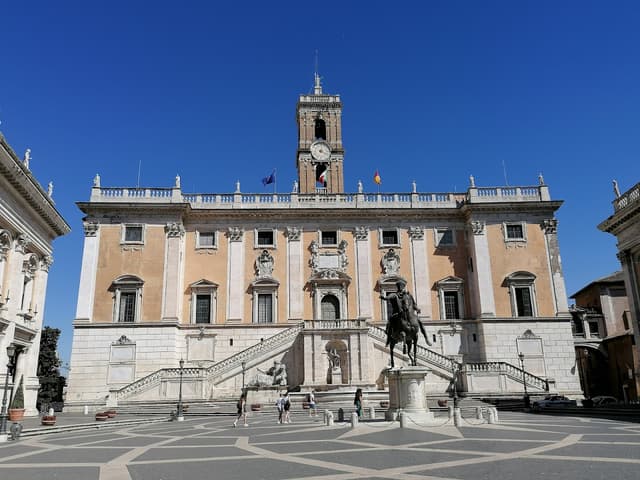
Campidoglio
@lindamiller
The Campidoglio, or Capitoline Hill, is one of the Seven Hills of Rome, Italy. It is located in the center of the city, and it is home to some of Rome's most important historical and cultural landmarks, including the Piazza del Campidoglio, the Capitoline Museums, and the Palazzo Senatorio.
The Campidoglio has been inhabited since the Bronze Age, and it was the site of the ancient Roman citadel. The Romans believed that the Campidoglio was the most sacred place in Rome, and it was the center of the city's political and religious life.
In the Middle Ages, the Campidoglio fell into disrepair. However, in the 16th century, Pope Paul III commissioned Michelangelo to redesign the Piazza del Campidoglio. Michelangelo's design for the Piazza is considered to be one of the masterpieces of Renaissance architecture.
Here are some of the things you can see and do on the Campidoglio:
Visit the Piazza del Campidoglio, Michelangelo's masterpiece of Renaissance architecture.
Visit the Capitoline Museums, which house a vast collection of ancient Roman and Renaissance art.
Visit the Palazzo Senatorio, the seat of the Rome City Council.
Climb to the top of the Cordonata, a grand staircase that leads up to the Piazza del Campidoglio.
Enjoy stunning views of the city from the Piazza del Campidoglio.
The Campidoglio is a beautiful and historic place, and it is a must-see for any visitor to Rome.

Details
On your right:
Palazzo dei Conservatori
@lindamiller
The Palazzo dei Conservatori is a Renaissance palace located on the Capitoline Hill in Rome, Italy. It is one of the two main buildings of the Capitoline Museums, along with the Palazzo Nuovo.
The Palazzo dei Conservatori was built in the 15th century by Pope Sixtus IV. It was originally the seat of the Conservatori, a group of elected magistrates who governed the city of Rome.
The Palazzo dei Conservatori houses a vast collection of ancient Roman and Renaissance art, including:
The Capitoline Wolf, a bronze statue of a she-wolf suckling Romulus and Remus, the legendary founders of Rome.
The Dying Gaul, a Roman copy of a Greek original from the 3rd century BC.
The Horse Tamers, a pair of bronze statues from the 2nd century AD.
The Capitoline Venus, a Roman copy of a Greek original from the 4th century BC.

Details
Keep walking around the Piazza. On your left:
Fountain of the Goddess Roma
@lindamiller
The Fountain of the Goddess Roma (Fontana della Dea Roma) is a fountain located in front of the Palazzo Senatorio, the town hall of Rome, Italy. It is one of the most iconic fountains in Rome, and it is a popular tourist destination.
The fountain was designed by Michelangelo in the 16th century, and it was completed in 1593. It is a large fountain, and it is decorated with a number of statues and reliefs.
The central figure of the fountain is a statue of the goddess Roma. Roma is depicted as a seated woman wearing a helmet and holding a spear. She is flanked by two statues of the Tiber and Aniene rivers.
The fountain also features a number of reliefs that depict scenes from Roman history. These reliefs include scenes from the Battle of Actium, the triumph of Julius Caesar, and the founding of Rome.

Details
Turn right onto Via del Campidoglio. There will be stairs. Pass by:
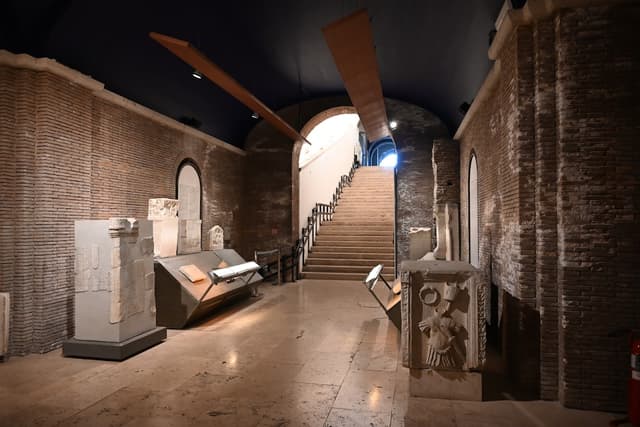
Galleria lapidaria
@lindamiller
The Galleria Lapidaria is a museum located in the Palazzo dei Conservatori on the Capitoline Hill in Rome, Italy. It houses a collection of over 3,500 stone tablets and inscriptions from ancient Rome.
The collection was originally started in the 16th century by Pope Sixtus IV. It was expanded in the 18th century by Pope Pius VII, who commissioned the construction of the Galleria Lapidaria to house the collection.
The Galleria Lapidaria is divided into two sections: the Roman section and the Christian section. The Roman section contains inscriptions from the Roman Republic and Empire, including laws, decrees, and dedications. The Christian section contains inscriptions from the early Christian Church, including epitaphs, baptismal fonts, and altars.
Some of the most notable items in the Galleria Lapidaria include:
The Lapis Niger, a black stone slab from the Roman Forum that is believed to mark the tomb of Romulus, the legendary founder of Rome.
The Tabula Siarensis, a bronze tablet from the 1st century BC that contains a copy of the Lex Julia Municipalis, a law that governed the cities of the Roman Empire.
The Epitaph of Eurysaces, a baker from the 1st century BC who is known for his elaborate tomb.
The Sarcophagus of Junius Bassus, a marble sarcophagus from the 4th century AD that depicts scenes from the life of Jesus Christ.

Details
On your left:
Esedra del Marco Aurelio
@lindamiller
The Esedra del Marco Aurelio is a large glass-walled hall located in the Palazzo dei Conservatori on the Capitoline Hill in Rome, Italy. It houses the bronze equestrian statue of Marcus Aurelius, one of the most iconic works of art in the world.
The statue was originally placed in the center of Piazza del Campidoglio, but it was moved to the Esedra in 1994 to protect it from the elements. The Esedra is a perfect setting for the statue, and it allows visitors to see the statue from all angles.
The statue of Marcus Aurelius is a masterpiece of Roman art. It is made of bronze and is about 4.2 meters tall. The statue depicts Marcus Aurelius riding a horse, and he is wearing a military cloak and helmet. The statue is known for its realistic depiction of Marcus Aurelius and his horse, as well as its expression of calm and serenity.

Details
On your left:
Tempio di Veiove
@lindamiller
The Temple of Veiove is a small Roman temple located on the Capitoline Hill in Rome, Italy. It was dedicated to the god Veiove, a deity of the underworld and of lightning.
The temple was built in the 2nd century BC, and it was restored by the emperor Domitius in the 1st century AD. It is a rectangular building with a pronaos and a cella. The pronaos is supported by four columns, and the cella is located at the back of the temple.
The temple was excavated in 1939, and it is now part of the Capitoline Museums. It is a rare example of a Roman temple dedicated to a deity of the underworld.

Details
Turn right onto Via Monte Tarpeo
Across the street:
Terrazza sul Foro
@lindamiller
The Terrazza sul Foro is a rooftop terrace located on the Capitoline Hill in Rome, Italy. It offers stunning views of the Roman Forum, the Colosseum, and the surrounding city.
The terrace is located on the roof of the Palazzo Nuovo, one of the two main buildings of the Capitoline Museums. It is accessible to the public for a small fee.
The Terrazza sul Foro was built in the 16th century by Pope Paul III. It was designed by Michelangelo as part of his redesign of the Piazza del Campidoglio.
The terrace is decorated with a number of statues and reliefs. These include statues of the Roman gods and goddesses, as well as reliefs depicting scenes from Roman history.
The Terrazza sul Foro is open from 9:00 AM to 7:00 PM.

Details
Pass by on your right in the distance:

Details
Take the stairs up to Piazza della Consolazione
Turn right onto Piazza della Consolazione
Pass by:

Details
Pass by
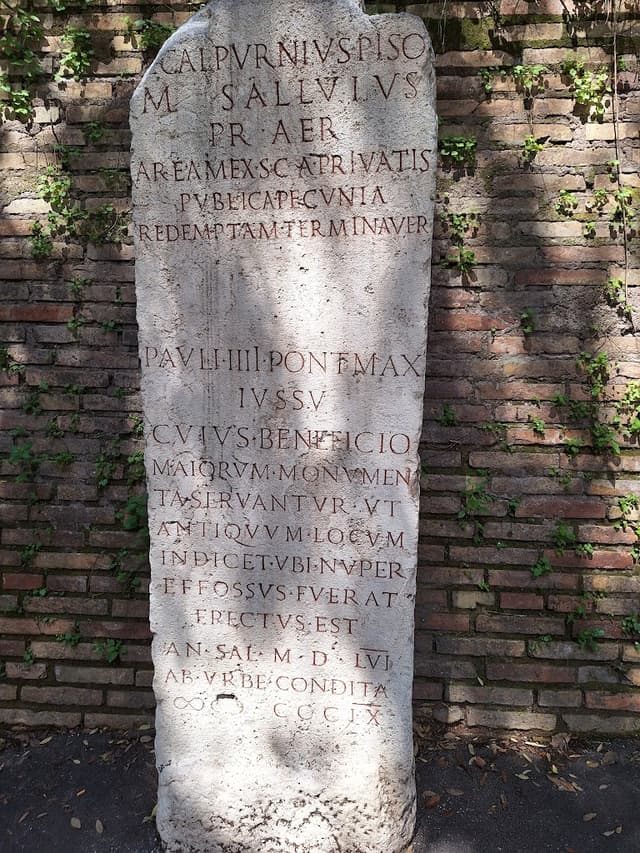
Targa di Paolo IV a Vico Jugario
@lindamiller
The Targa di Paolo IV is a plaque located in Vico Jugario, a small street in the Campitelli district of Rome, Italy. It commemorates the restoration of a Roman stele by Pope Paul IV Carafa in 1556.
The stele is a rectangular stone block that once marked the boundary of the Area Saturni, a commercial district located in front of the nearby Temple of Saturn. It is inscribed with a Latin text that reads:
Calpurnius Piso, aedilis, aream Saturni a fundamentis extruxit et publico usui destinavit. Hoc monumentum Paulus IV papa anno ab urbe condita MMDCVII in pristinum statum restituit.
Translation:
Calpurnius Piso, the aedile, built the Area Saturni from the foundations and dedicated it to public use. Pope Paul IV restored this monument to its original state in the year 2309 from the founding of Rome.
The stele was discovered in 1556 during excavations in Vico Jugario. Pope Paul IV ordered that it be restored and placed in its original location. The plaque was added to the stele in 1556 to commemorate the restoration.
The Targa di Paolo IV is a significant historical marker. It provides evidence of the commercial activity that took place in the Area Saturni during ancient Rome. It also provides a record of Pope Paul IV's commitment to preserving the city's ancient heritage.
The plaque is located on the right-hand side of Vico Jugario, just before it intersects with Via del Campidoglio. It is a small, rectangular plaque that is made of marble. The inscription is in Latin and is written in capital letters.

Details
At the plaque, turn left onto Via di S. Giovanni Decollato/Piazza della Consolazione
Continue to follow Via di S. Giovanni Decollato
Continue onto Piazza della Bocca della Verità
Turn left onto Piazza della Bocca della Verità
Continue until the Mouth of Truth. By now it is probably ~4:30. Our reservation is at 6:00.
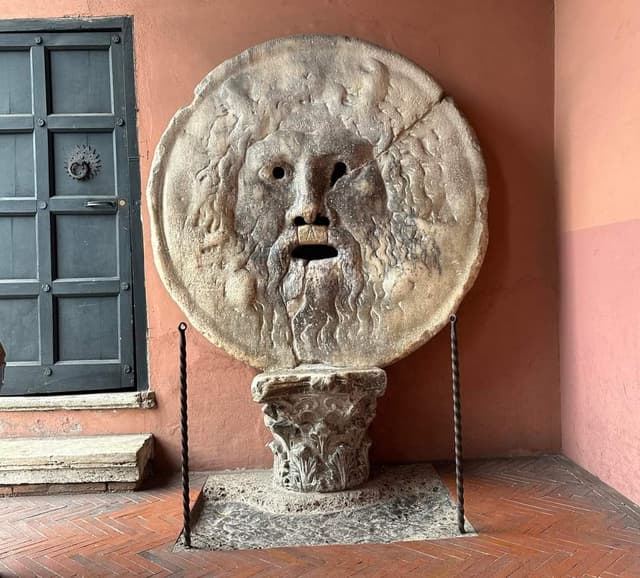
Mouth of Truth
@lindamiller
The Mouth of Truth (Italian: Bocca della Verità) is a marble mask in Rome, Italy, which stands against the left wall of the portico of the Santa Maria in Cosmedin church, at the Piazza della Bocca della Verità, the site of the ancient Forum Boarium.
According to enduring medieval legend, the mouth will bite off the hand of any liar who places their hand in its mouth, or, alternatively, any who utters a lie while their hand is in the mouth. It still attracts many visitors who audaciously insert their hands.
The Mouth of Truth is an oval mask with a large, open mouth, a wide nose, and two small eyes. It is made of Carrara marble and is thought to date back to the 1st or 2nd century AD. The original purpose of the mask is unknown, but it is thought that it may have been used as a drain cover or a fountainhead.
The legend of the Mouth of Truth first appeared in the 13th century. One popular story tells of a woman who was accused of adultery. She was brought before the mask and asked to place her hand in its mouth. The woman swore that she was innocent, and she placed her hand in the mouth of the mask. However, the mask bit off her hand, proving that she was lying.
Another story tells of a man who was accused of stealing money. He was brought before the mask and asked to place his hand in its mouth. The man swore that he was innocent, and he placed his hand in the mouth of the mask. However, the mask did not bite off his hand. The man was then released, and it was proven that he was innocent.
The Mouth of Truth is a fascinating and mysterious object. It is a reminder of the rich history and culture of Rome. It is also a reminder of the power of stories and legends.

Details
Across the street:
Fountain of the Tritons
@lindamiller
The Fountain of the Tritons in Piazza Bocca della Verità is one of two fountains in Rome dedicated to the Tritons. This one is a smaller fountain than the Triton Fountain in Piazza Barberini. It was designed by Carlo Francesco Bizzaccheri in the 18th century and was commissioned by Pope Clement XII Corsini. The fountain depicts two Tritons holding up a large vase.

Details
Shorter route that goes straight to the restaraunt. Scroll down to the Monument to Giuseppe Mazzini.
Longer route to see the Terrace and the Keyhole:
Head south on Piazza della Bocca della Verità toward Via della Greca
Continue onto Via di Santa Maria in Cosmedin
Turn left onto Clivo di Rocca SavellaTake the stairs
Turn right at Viale Nino Manfredi
Giardino degli Aranci
@lindamiller
The Terrazza Belvedere Aventino, also known as the Giardino degli Aranci, is a terraced garden located on the Aventine Hill in Rome, Italy. It offers stunning views of the city, including the Colosseum, the Roman Forum, and St. Peter's Basilica.
The garden is named for the orange trees that grow there. The trees were planted in the 17th century by Cardinal Scipione Borghese, who also built the terrace and used it as a private garden. It was later opened to the public in the 19th century.
The garden is home to a variety of trees and plants, including orange trees, palm trees, and cypresses. It also has a number of fountains and sculptures, including a statue of the Roman goddess Diana.
The garden is named for the orange trees that grow there. The trees were planted in the 17th century by Cardinal Scipione Borghese, who used the garden as a private retreat. The garden was later opened to the public in the 19th century.

Details
Head southeast on Viale Nino Manfredi toward Piazza Fiorenzo Fiorentini
Turn right onto Viale Michele Galdieri
Turn right onto Piazza Pietro D'Illiria
Turn left to stay on Piazza Pietro D'Illiria
Pass by:
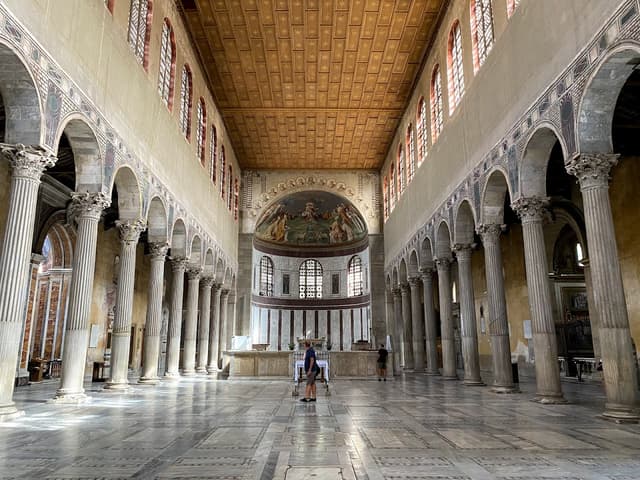
Basilica di Santa Sabina all'Aventino
@lindamiller
The Basilica di Santa Sabina all'Aventino is a Roman Catholic basilica located on the Aventine Hill in Rome. It is one of the oldest surviving churches in Rome and is a UNESCO World Heritage Site.
The basilica was founded in the 5th century by Peter of Illyria, a Dalmatian priest. It was dedicated to Saint Sabina, a Roman matron who was martyred in the 3rd century.
The basilica is a three-aisled structure with a nave (central part of a church), two aisles, and an apse (an area with a domed roof usually containing the altar). The nave is divided by 24 Corinthian columns, which support a clerestory, a windowed wall that is carried higher than the surrounding roofs to light the interior space. The apse is decorated with a mosaic depicting the Virgin Mary and Child.
The basilica is known for its beautiful mosaics, which were created in the 6th century. The mosaics in the nave depict scenes from the Old and New Testaments.
The basilica is also home to a number of other notable artworks, including a wooden door from the 6th century and a pulpit from the 13th century.
Here are some tips for visiting the Basilica di Santa Sabina:
The basilica is open from 7:00 a.m. to 7:00 p.m.
Admission is free.
The best time to visit is in the morning or evening, when the crowds are smaller.

Details
Head southwest toward Via di Santa Sabina/P.za di Sant'Alessio
Turn right onto Via di Santa Sabina/P.za di Sant'Alessio
Continue to follow Via di Santa Sabina
Continue onto Piazza dei Cavalieri di Malta
Pass by:
Fontanella nel Giardino di Sant'Alessio
@lindamiller
The Fontanella nel Giardino di Sant'Alessio is a fountain located in the garden of the Basilica di Sant'Alessio in Rome, Italy. It is a small, but elegant fountain that was originally located in the Palazzo Accoramboni, which was demolished in the early 20th century.
The fountain was moved to the garden of Sant'Alessio in 1937. It is made of travertine and marble and features a basin that is supported by a pair of dolphins. In the center of the basin is a statue of a bird, which is believed to be a peacock. The bird is spouts water from its mouth.

Details
Pass by:
Gardens of Gran Priorato di Roma dell'Ordine di Malta
@lindamiller
The garden of the Gran Priorato di Roma dell'Ordine di Malta is a beautiful and tranquil space located on the Aventine Hill in Rome, Italy. The garden is open to the public for tours and is a popular spot for visitors to enjoy the views of the city.
The garden is divided into two sections: the upper garden and the lower garden. The upper garden is the more formal of the two, with manicured lawns, hedges, and flowers. The lower garden is more informal, with trees, shrubs, and a small fountain.
A highlight of the garden is the Buco della Serratura, or "Keyhole View." This is a small hole in the door of the Villa del Priorato di Malta that frames a view of the dome of St. Peter's Basilica. The view is said to be one of the best in Rome.

Details
See the "Famous Keyhold"
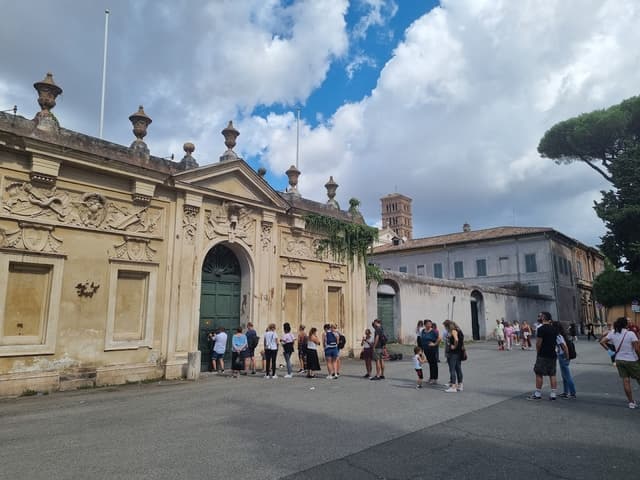
Buco della serratura dell’Ordine di Malta
@lindamiller
The Buco della Serratura dell'Ordine di Malta (Keyhole of the Order of Malta) is a small hole in the door of the Villa del Priorato di Malta, a building in Rome that is the seat of the Sovereign Military Order of Malta. The hole provides a unique view of the dome of Saint Peter's Basilica.
The hole is located at the top of a short flight of stairs in the Piazza dei Cavalieri di Malta, a small square on the Aventine Hill. The square is surrounded by 17th-century buildings, including the Church of Santa Maria del Priorato, which is also owned by the Order of Malta.
To see the view through the hole, visitors must line up and wait their turn. The hole is small, and the view is limited, so it is best to visit early in the morning or late in the afternoon when the crowds are smaller.
Here are some additional details about the Buco della serratura dell'Ordine di Malta:
--The hole was created in the 18th century by the architect Piranesi.
--The hole is about 10 centimeters in diameter.
--The view through the hole is about 100 meters from the dome of Saint Peter's Basilica.
The Buco della serratura dell'Ordine di Malta is a free attraction. It is open to the public from 9:00 a.m. to 7:00 p.m. daily.

Details
Turn around and go back the way you came.
Go around the curve. On your right:

Monastero delle Benedettine Camaldolesi
@lindamiller
The Monastero delle Benedettine Camaldolesi is a Benedictine monastery located in Rome, Italy. It is located on the Aventine Hill, at the intersection of Clivo dei Publicii and Via di San Francesco di Paola.
The monastery was founded in the 11th century by San Romualdo, the founder of the Camaldolese order. It was originally a male monastery, but it became a female monastery in the 13th century.
The monastery is home to a community of Benedictine nuns who live according to the Rule of Saint Benedict. The nuns are dedicated to a life of prayer, work, and study.
The monastery is open to the public for visits. Visitors can tour the monastery and the church, and they can also attend Mass or other religious services.
History
The Monastero delle Benedettine Camaldolesi was founded in the 11th century by San Romualdo, the founder of the Camaldolese order. San Romualdo was a monk who was dissatisfied with the laxity of monastic life in his day. He founded the Camaldolese order to promote a more rigorous and contemplative form of monastic life.
The monastery was originally a male monastery, but it became a female monastery in the 13th century. The first abbess of the monastery was Santa Giuliana Falconieri, who was canonized in 1743.

Details
Keep going through the rose garden:
Roseto comunale
@lindamiller
The Roseto Comunale is a public rose garden located on the Aventine Hill in Rome, Italy. It is home to over 1,000 varieties of roses.
The rose garden was founded in 1932 by the Contessa Lavinia Boncompagni Ludovisi. The contessa was a passionate gardener, and she wanted to create a place where people could enjoy the beauty of roses.
The rose garden is divided into two sections: the main collection and the exhibition area. The main collection contains roses from all over the world, including hybrid tea roses, floribundas, grandifloras, and shrub roses. The exhibition area is used to showcase new varieties of roses.
The rose garden is open to the public from March to October. During this time, the garden is in full bloom, and visitors can enjoy the beauty of the roses.

Details
If the shorter route is chosen, go straight from the Mouth of Truth to here:
Pass by:
Monument to Giuseppe Mazzini
@lindamiller
The Monument to Giuseppe Mazzini (Monumento a Giuseppe Mazzini) is a large marble monument located on the Aventine Hill in Rome, Italy. It was built to commemorate Giuseppe Mazzini, an Italian politician, journalist, and activist who played a leading role in the unification of Italy.
The monument was designed by the Italian sculptor Ettore Ferrari and was inaugurated in 1949. It is a large rectangular structure with a statue of Mazzini seated in the center. The statue is surrounded by a number of other statues and reliefs that depict Mazzini's life and work.

Details
Turn right onto Via del Circo Massimo
Cross the street toward Viale Aventino
Turn right toward Viale Aventino. Turn left, then right and follow the curve around. Pass by:
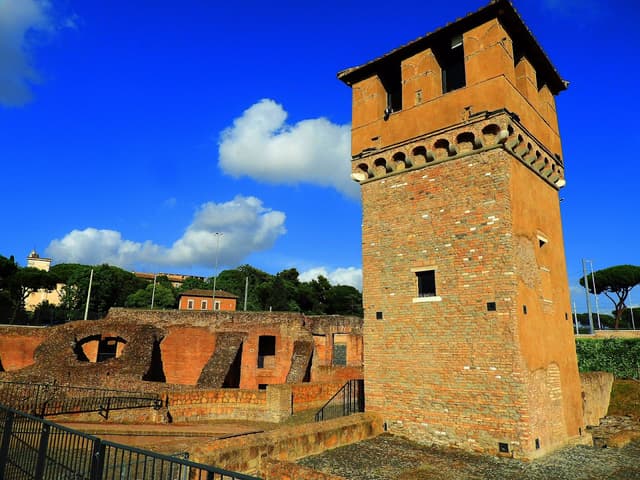
Torre della Moletta
@lindamiller
The Torre della Moletta is a medieval tower located in the archaeological complex of the Circus Maximus. It is a square tower, built in tuff with limestone splinters, flint, and irregular courses of bricks; it was surrounded by modest buildings and must have been part of a system of fortifications, demolished in 1943.
The tower is named for the fact that it once stood near a mill operated by the water of the Fosso di San Giovanni, a stream that runs through the Circus Maximus. The tower is thought to have been built in the 12th century by the Frangipane family, who owned the land around the Circus Maximus.
The tower is a well-preserved example of medieval architecture. It is a sturdy structure, built to withstand attack. The tower is also a valuable historical resource, providing insights into the medieval history of Rome.
The Torre della Moletta is a popular tourist destination. It is open to the public and can be visited as part of a tour of the Circus Maximus.

Details
Cross Via dei Cerchi/Piazza di Porta Capena
On your right:
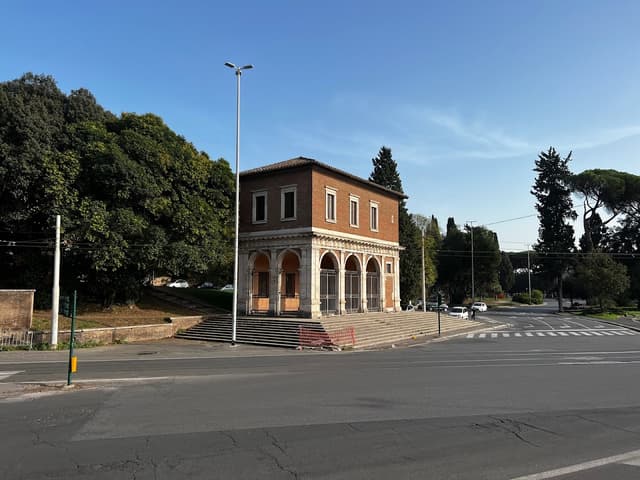
Casina del Vignola Boccapaduli
@lindamiller
The Casina del Vignola Boccapaduli is a small, Renaissance-era building located in Piazza di Porta Capena in Rome, Italy. It was built in the 16th century and is named after its architect, Giacomo Vignola.
The Casina was originally located in a vineyard near the Terme di Caracalla. It was purchased by Prospero Boccapaduli, a Roman nobleman, in 1538. Boccapaduli may have commissioned Vignola to design the building, but there is no definitive proof.
The Casina is a two-story building with a square plan. The ground floor has a portico with three arches, and the upper floor has two windows. The building is made of travertine and is decorated with Doric columns and pilasters.
The Casina was used as a country house by the Boccapaduli family. It was also used as a hospital during the Napoleonic Wars and as a barracks during the Second World War.
In 1910, the Casina was dismantled and rebuilt in its current location in Piazza di Porta Capena. It was restored in the 1990s and is now used as a museum.

Details
Pass by:
Septizodium
@lindamiller
The Septizodium was a three-tiered nymphaeum (a monumental fountain) built by the Roman emperor Septimius Severus in the early 3rd century AD. It was located on the Palatine Hill in Rome, and was visible to travelers arriving on the Via Appia.
The Septizodium was named for its seven exedrae (niches), which were decorated with statues and fountains. It is thought that the exedrae were dedicated to the seven planetary deities: Saturn, Jupiter, Mars, Mercury, Venus, the Sun, and the Moon.
The Septizodium was a popular tourist attraction in its time, and was mentioned by several Roman writers, including Ammianus Marcellinus and Cassiodorus. However, it fell into disrepair after the fall of the Western Roman Empire, and was eventually demolished in the 16th century.
Today, only the foundations of the Septizodium remain. However, there are several Renaissance drawings and paintings that depict the monument, which give us an idea of what it once looked like.

Details
On the left in the distance:
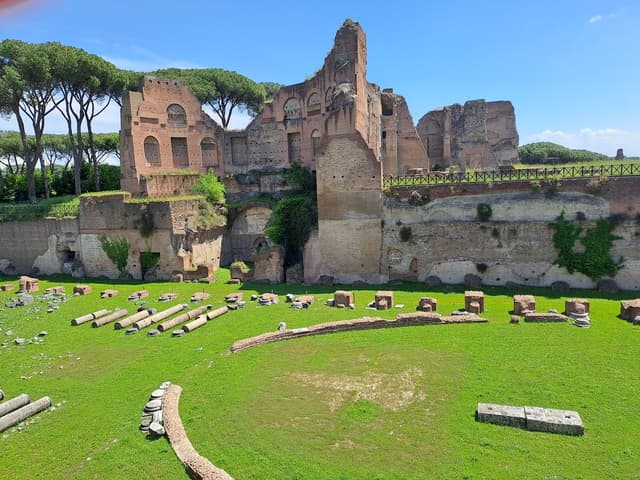
Domus Severiana
@lindamiller
The Domus Severiana is a modern name given to the final extension to the imperial palaces on the Palatine Hill in Rome, built to the south-east of the Stadium Palatinum in the Domus Augustana of Septimius Severus. It included the Baths of Septimius Severus (Latin: Balneum Palatii).
All that remains of the building are the imposing brick substructures at the corner of the hill, which created an artificial platform at the same level as the palace of Domitian, extending it, since the emperors had run out of space on the hill.
They were fed by a branch of the Aqua Claudia, which spanned the valley between the Palatine Hill and the Caelian Hill and whose arches are still visible. On the side facing the via Appia, Septimius Severus commissioned an impressive three-level facade akin to the scaenae frons in a theatre, with fountains and colonnades. This became known as the Septizodium. It is said that the emperor monumentalised this side of the building to impress his fellow Africans, who would arrive in Rome along the via Appia. The Septizodium's remains were demolished in the 16th century and it is only known from Renaissance drawings.
The Domus Severiana was a vast and luxurious complex, and it is thought to have been the main residence of the emperors during the Severan dynasty. It was also used for official functions and ceremonies.

Details
Pass by:
Aqua Claudia
@lindamiller
The Aqua Claudia, also known as the Claudian Aqueduct, was an ancient Roman aqueduct that supplied water to the city of Rome. It was begun by Emperor Caligula in 38 AD and finished by Emperor Claudius in 52 AD. The aqueduct was 69 kilometers (43 miles) long and delivered 184,000 cubic meters (6.5 million cubic feet) of water per day.
The Aqua Claudia was one of the most impressive aqueducts ever built. It was constructed from concrete and travertine marble, and it was supported by a series of arches that reached heights of up to 30 meters (100 feet). The aqueduct was also notable for its use of siphons, which allowed it to cross valleys and other obstacles.
The Aqua Claudia supplied water to the Caelian and Esquiline Hills in Rome. It was used to feed public baths, fountains, and private homes. The aqueduct remained in use until the 6th century AD, when it was damaged by the Ostrogoths.

Details
On your left. This is also where the crosswalk is.

Details
After you cross the street, in front of you will be:
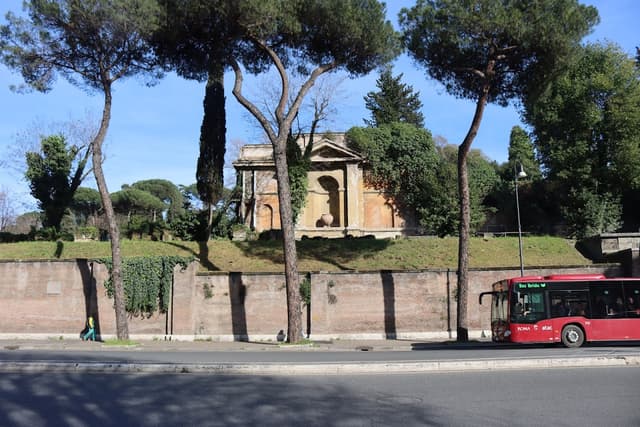
Antiquarium comunale del Celio
@lindamiller
The Antiquarium comunale del Celio was a museum of ancient Roman artifacts located on the Celio Hill in Rome, Italy. The museum was founded in 1894 to house artifacts from excavations in the area, but it was closed in 1939 due to damage caused by construction work on the nearby subway line. The museum's collection, which is estimated to contain over 80,000 artifacts, has been dispersed to other museums and storage facilities.
The museum was located in a building designed by Costantino Sneider and completed in 1890. The building was a simple rectangular structure with a portico on the front. The interior of the museum was divided into two main rooms, each of which was dedicated to a different period of Roman history.
The museum's collection included a wide variety of artifacts, including sculptures, pottery, jewelry, and coins. Some of the most notable pieces in the collection included:
A marble statue of a young woman, known as the Celio Venus, dating from the 2nd century AD.
A collection of terracotta figurines from the Esquiline Necropolis, dating from the 1st century BC to the 1st century AD.
A collection of votive offerings from the temple of Minerva Medica, dating from the 1st century AD.

Details
Go left.
Pass by:
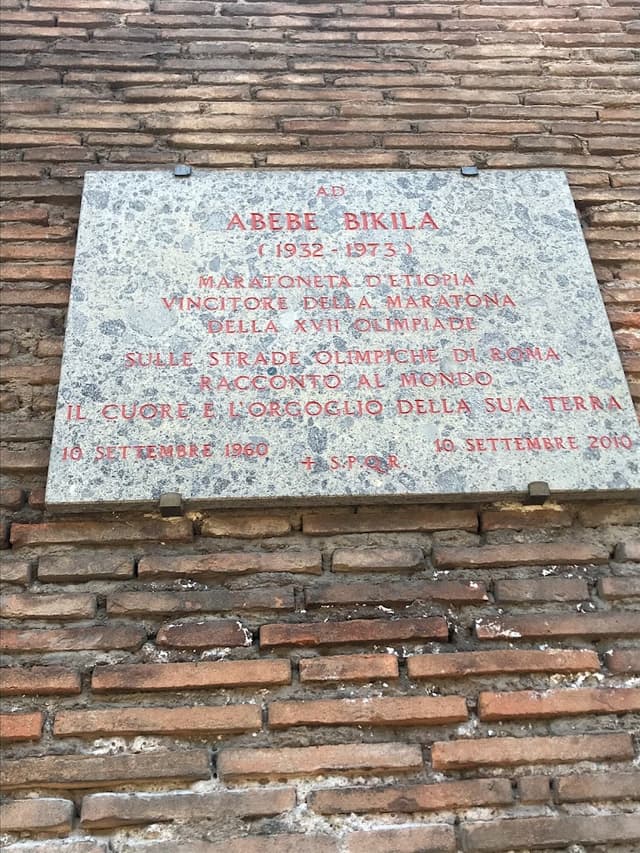
Targa in ricordo della vittoria olimpica del maratoneta etiope Abebe Bikila
@lindamiller
The plaque in memory of the Olympic victory of the Ethiopian marathon runner Abebe Bikila is located in Via San Gregorio, in the Rione Celio of Rome, Italy. It commemorates Bikila's victory in the men's marathon at the 1960 Summer Olympics in Rome. Bikila won the race in a time of 2:15:16, setting a new world record. He is the first black African to win an Olympic gold medal.
The plaque is made of bronze and is mounted on a stone wall. It is inscribed with the following text:
Abebe Bikila
1932-1973
Campione Olimpico
Maratona
Roma 1960
The plaque was placed in 2010, on the 50th anniversary of Bikila's victory. It is a popular tourist destination and is a reminder of Bikila's historic achievement.
Here is a translation of the plaque's inscription:
Abebe Bikila
1932-1973
Olympic Champion
Marathon
Rome 1960
Bikila's victory was a major upset. He was a relatively unknown runner at the time, and he was competing in his first Olympic Games. He had trained for the race barefoot, and he wore no shoes during the race.

Details
Follow the street around to the right. It turns into Via Celio Vibenna
Pass a park on your right.
Parco del Celio
@lindamiller
Parco del Celio is a small green area at the top of the Caelian Hill, and it is worth visiting for the stunning view over the Colosseum.

Details
Slight right onto Via Capo d'Africa
Hotel is three blocks down on the left.
In front of you as you walk down the street:

Basilica e Monastero Agostiniano Santi Quattro Coronati
@lindamiller
The Basilica and Monastery of Santi Quattro Coronati is a religious complex located on the Celio Hill in Rome. It is one of the most important monastic complexes in Rome and is home to a large collection of art and architecture.
The basilica is dedicated to four anonymous saints who were martyred during the reign of Diocletian. The complex was founded in the 5th century AD and has been rebuilt and expanded several times over the centuries.
The basilica is a beautiful example of Romanesque architecture. It has a nave, two aisles, and a transept. The interior is decorated with frescoes and mosaics, including a 12th-century mosaic of the Last Judgment.
The monastery is located behind the basilica. It is a walled complex that includes a cloister, a library, and a refectory. The cloister is decorated with cosmatesque mosaics, which are a type of inlaid marble work that is characteristic of Rome.
Monastero
The monastery is located behind the basilica. It is a walled complex that includes a cloister, a library, and a refectory.
The cloister is the most famous part of the monastery. It is also decorated with cosmatesque mosaics. These mosaics depict scenes from the Old and New Testaments.
The library of the monastery is home to a collection of manuscripts and books. The refectory of the monastery is a large room where the monks eat their meals.
Other features
The complex also includes a number of other features, including:
The Torre Maggiore, a large tower that was built in the 12th century.
The Chapel of Saint Sylvester, which was built in the 12th century.
The Chapel of Santa Barbara, which was built in the 13th century.

Details
The restaurant is in the Hotel Capo 'Africa
Le Terrazze al Colosseo
@lindamiller
I sent them a request for 6 PM. Le Terrazze al Colosseo are two rooftop terraces located at the top of the Hotel Capo d'Africa in Rome, Italy. The terraces offer stunning views of the Colosseum and the surrounding city.
The restaurant serves a variety of Italian dishes, and the bar offers a selection of cocktails and wines. The terraces are also a popular spot for events, such as weddings and parties.
The terraces were created in 2022 by Massimo Salerno, the owner of Mchef Italia. Salerno wanted to create a space where people could enjoy the views of the Colosseum and the city in a relaxed and elegant setting. The terraces have been a popular addition to Rome's tourist scene, and they offer a unique and unforgettable experience.

Details
* * *

